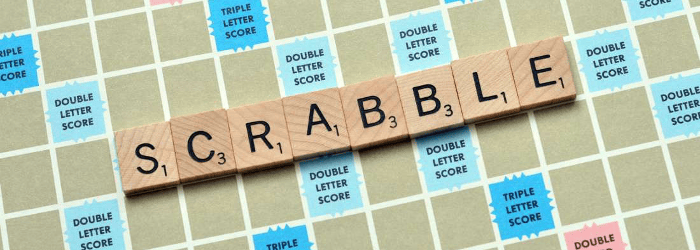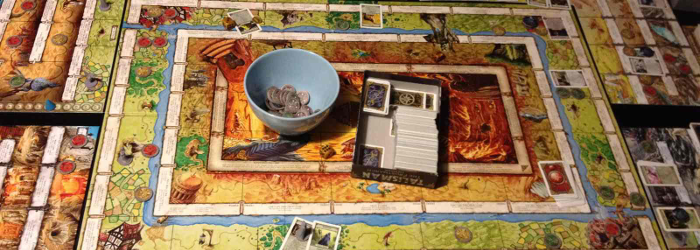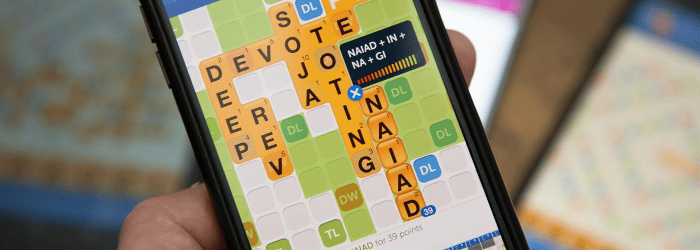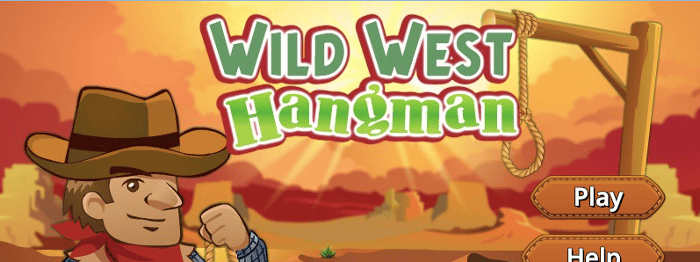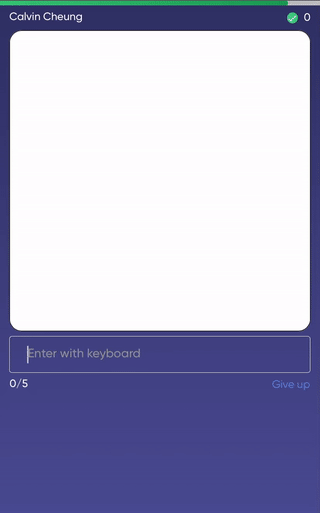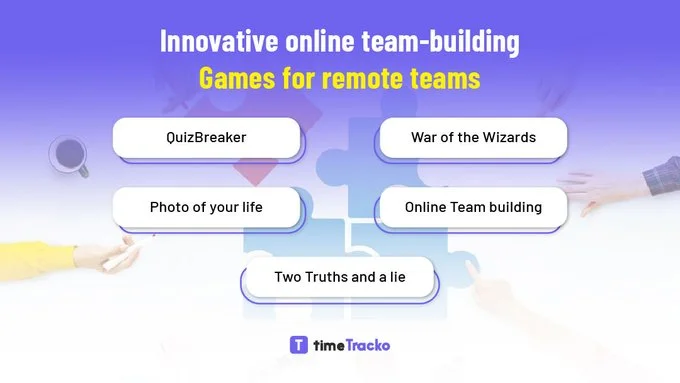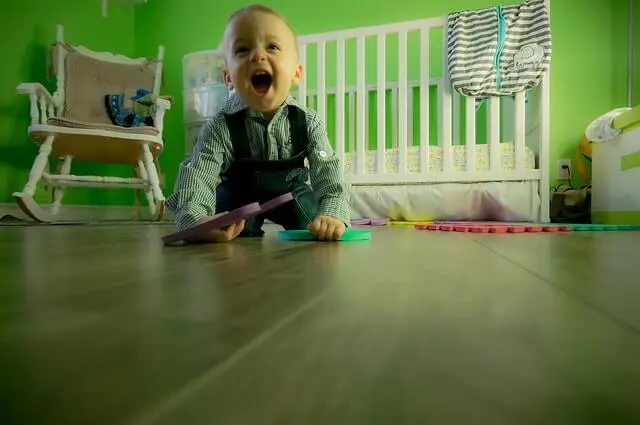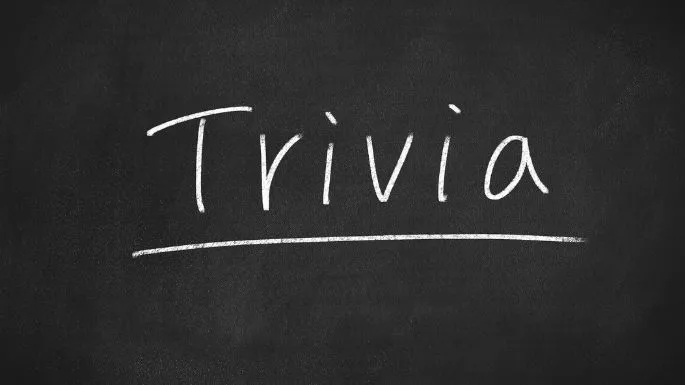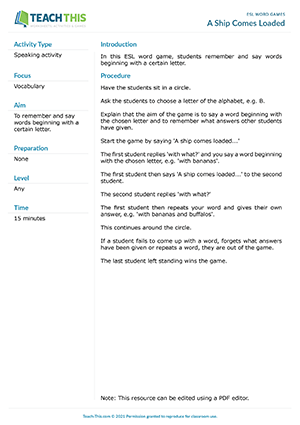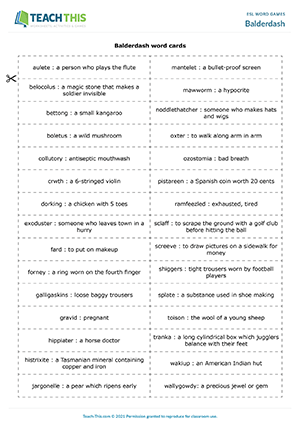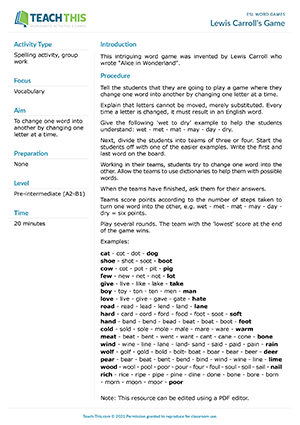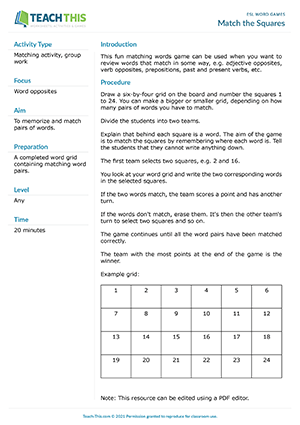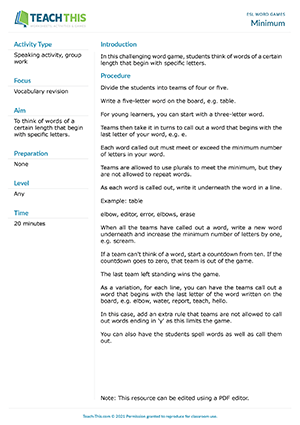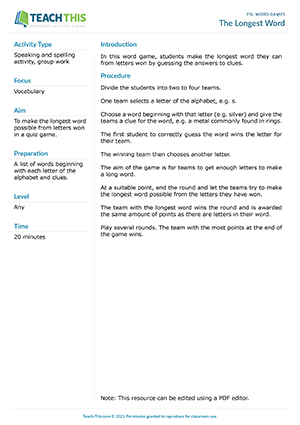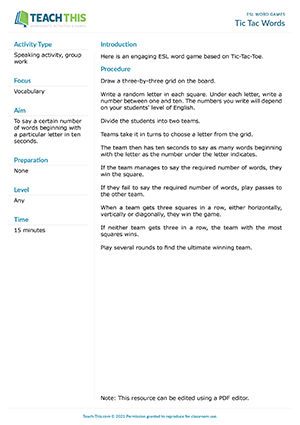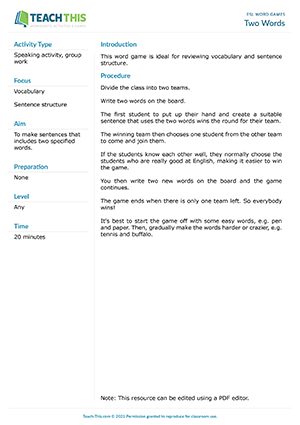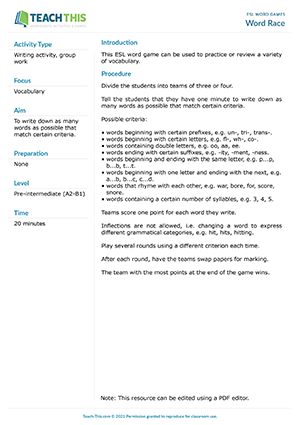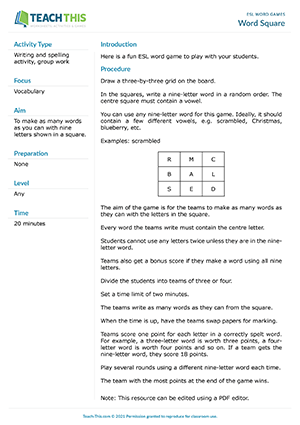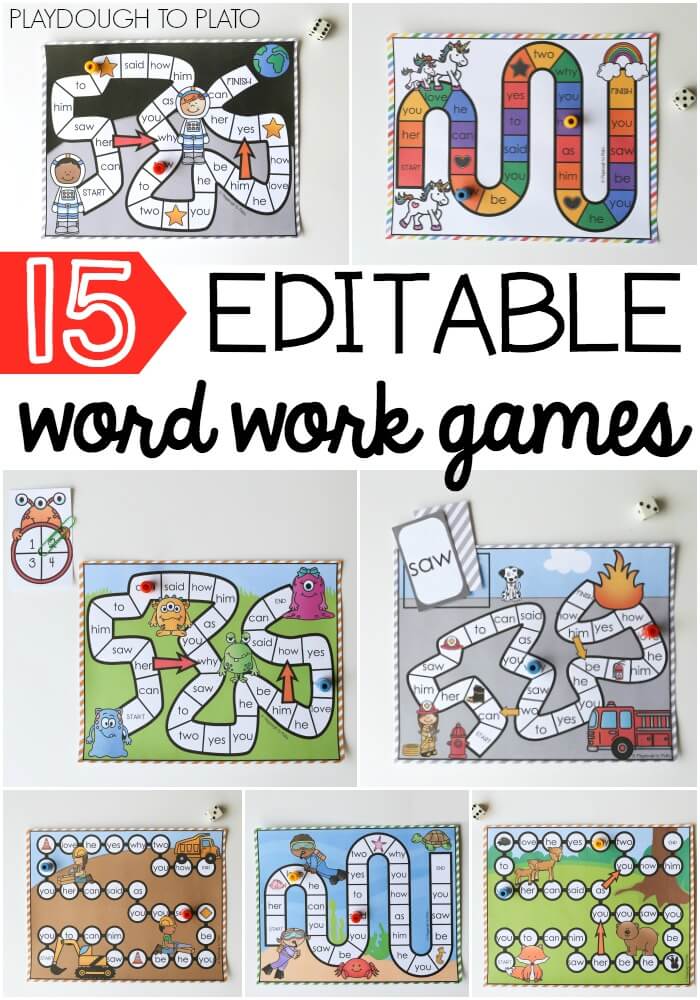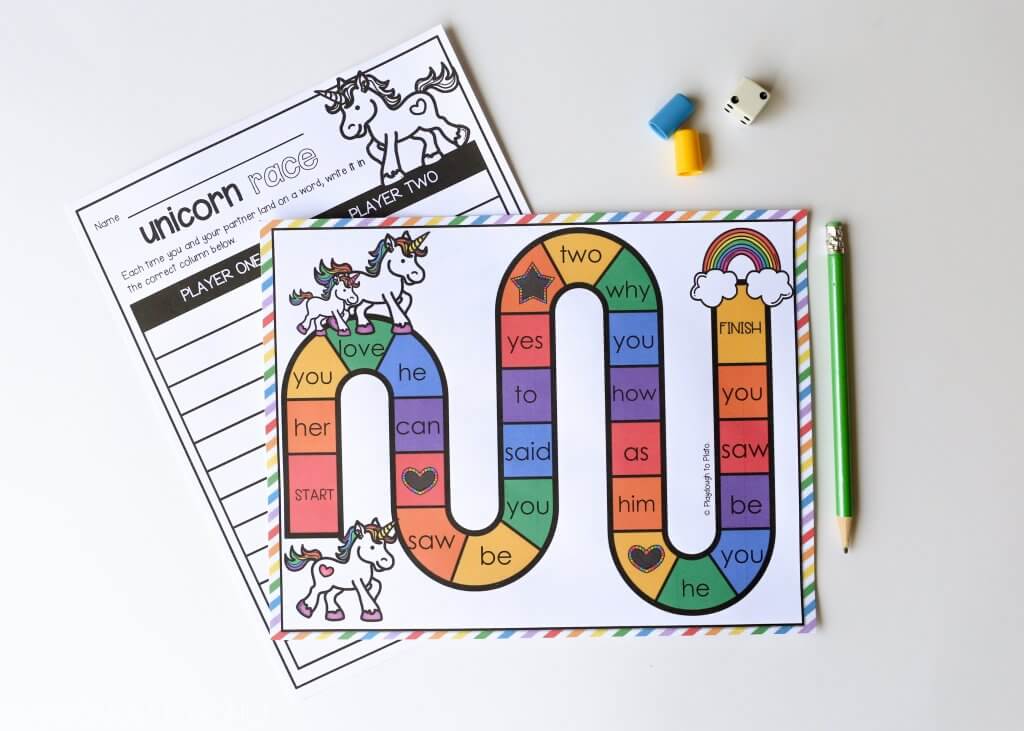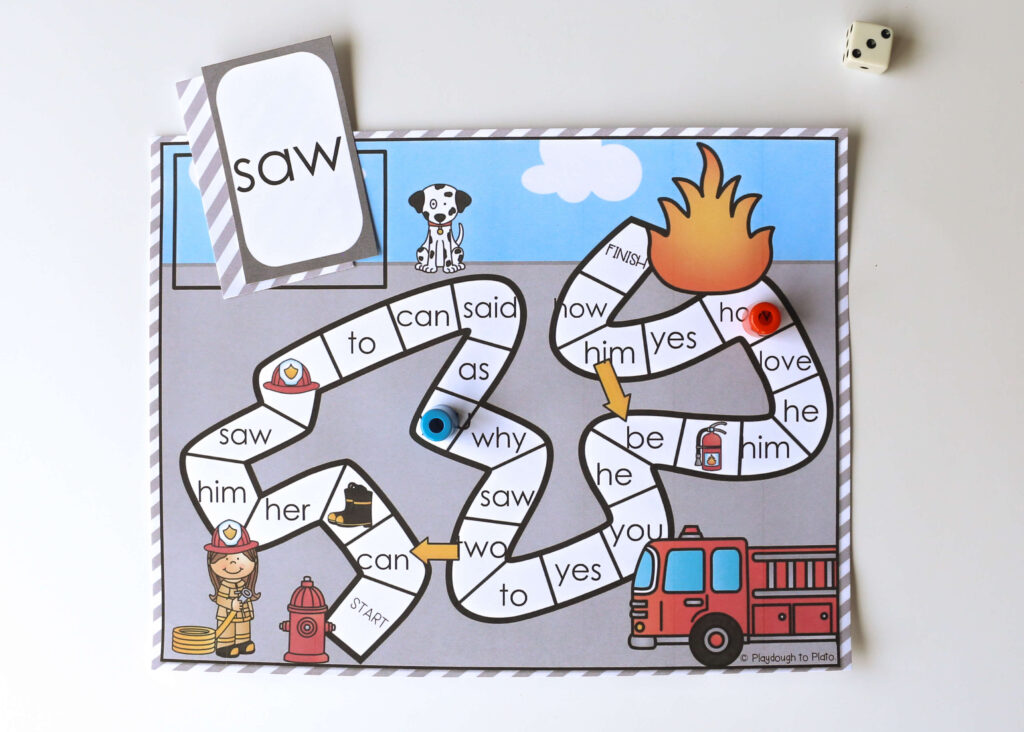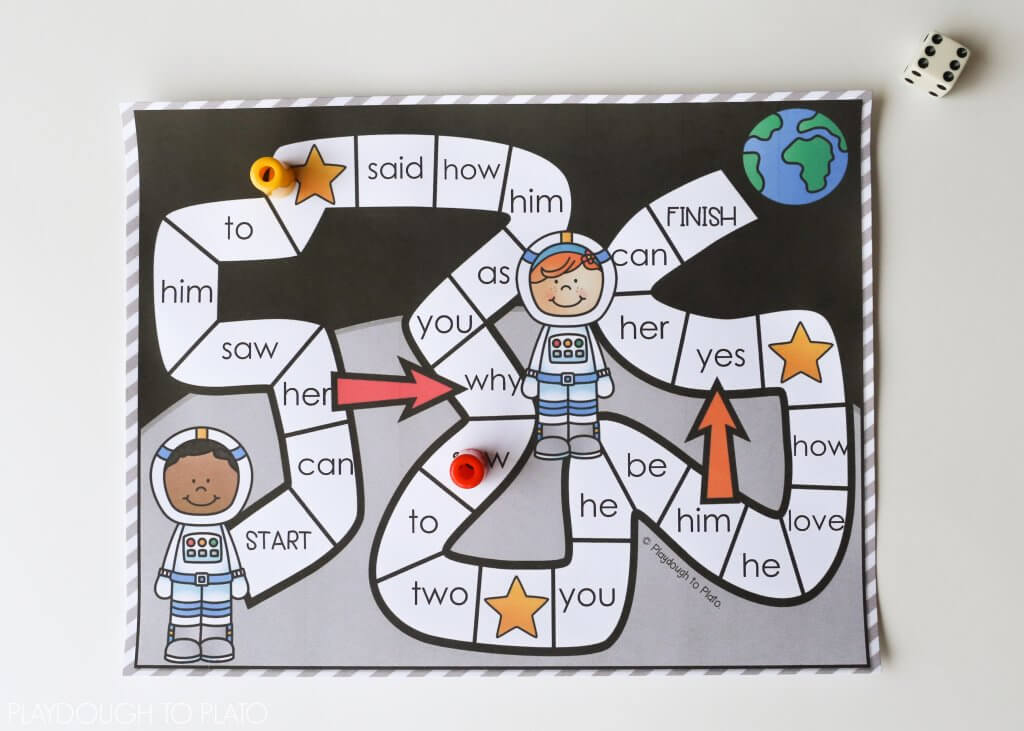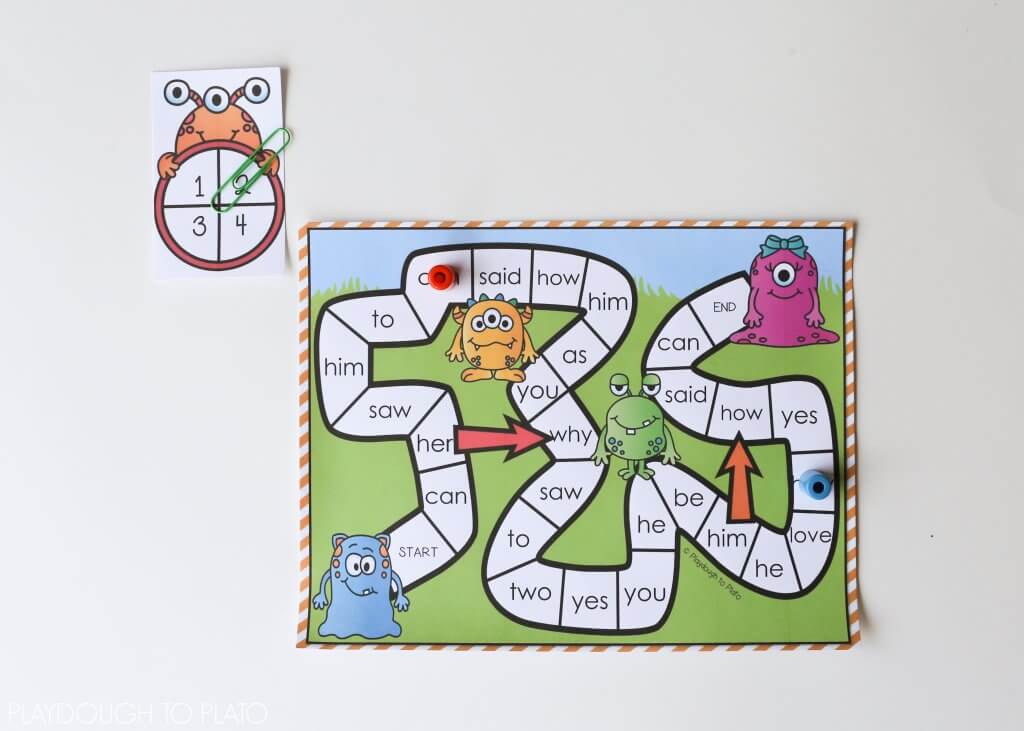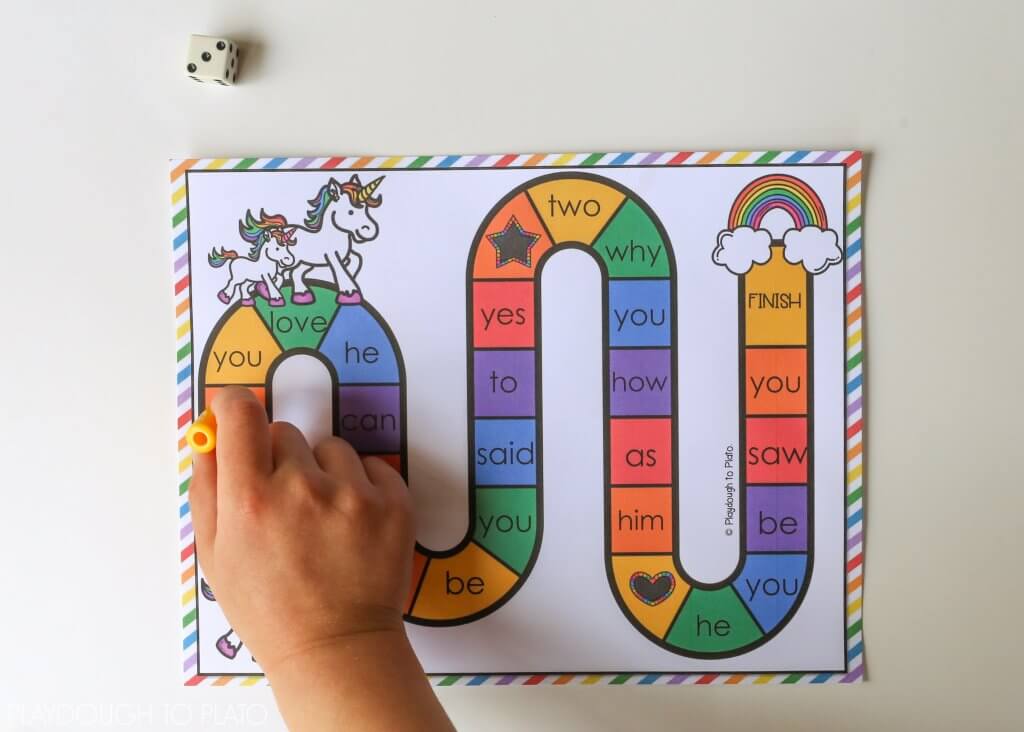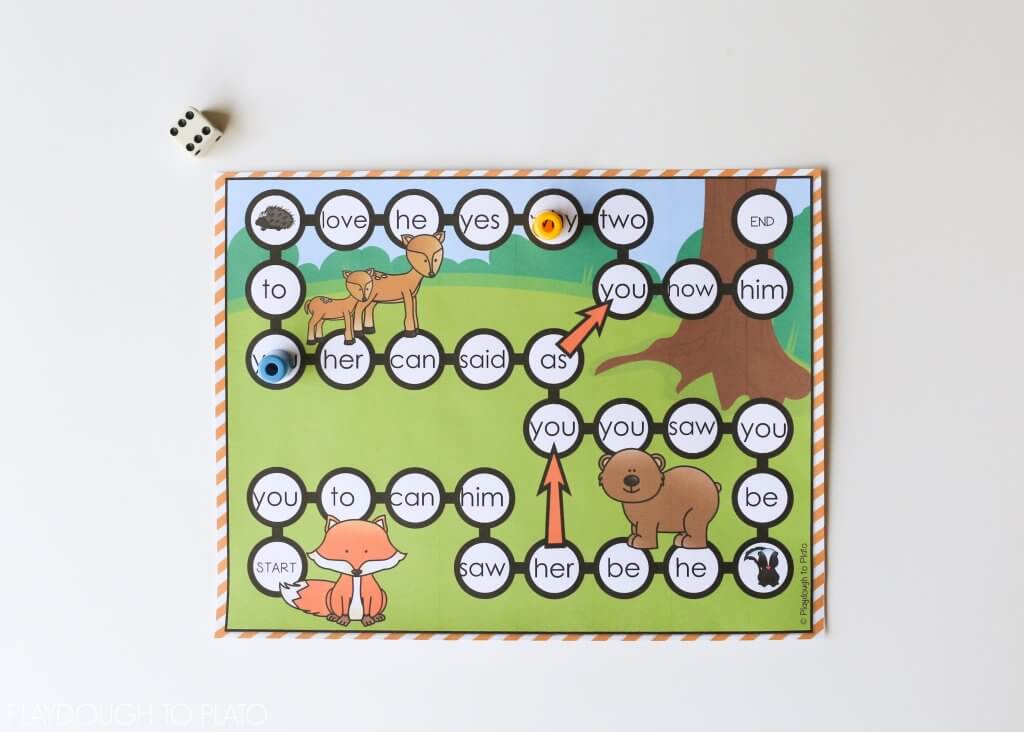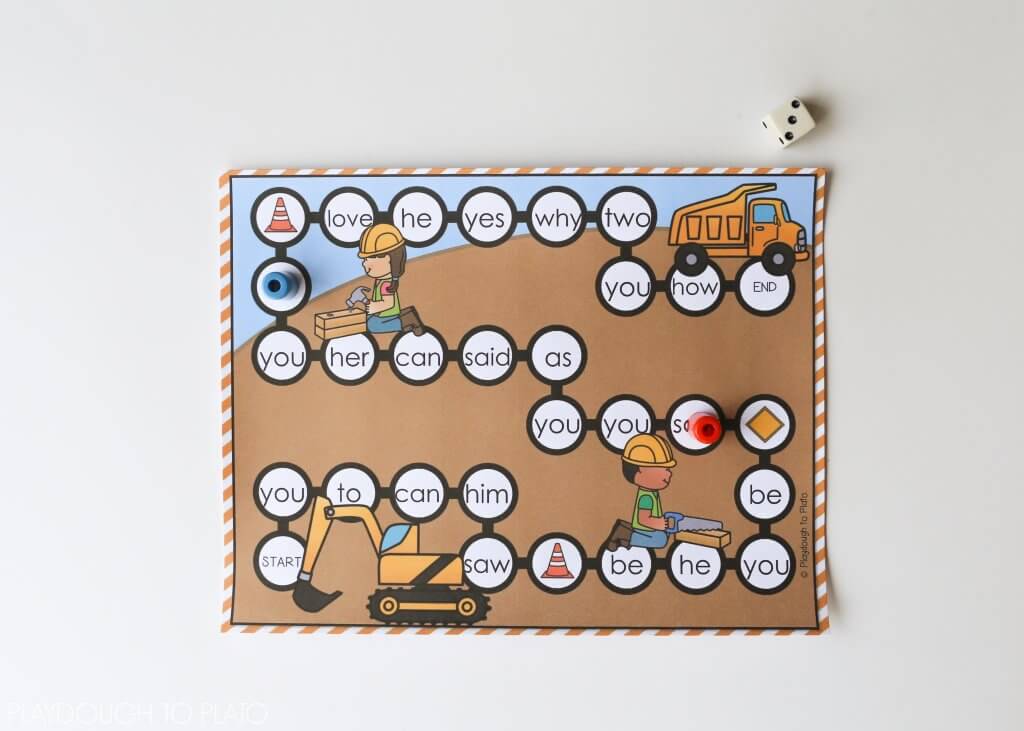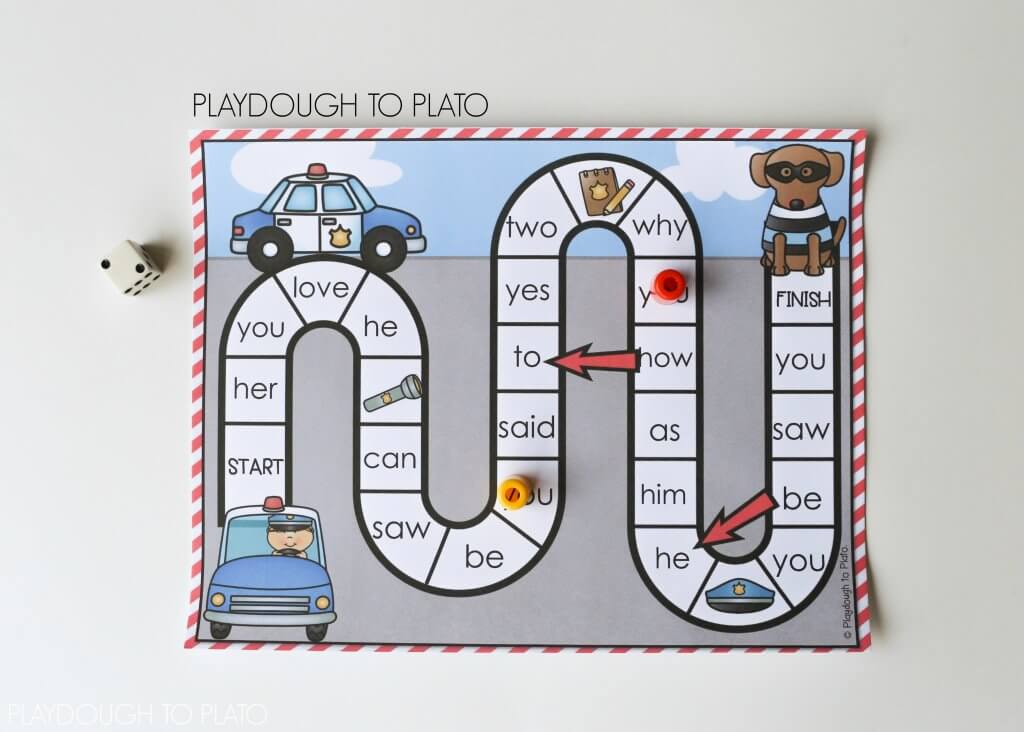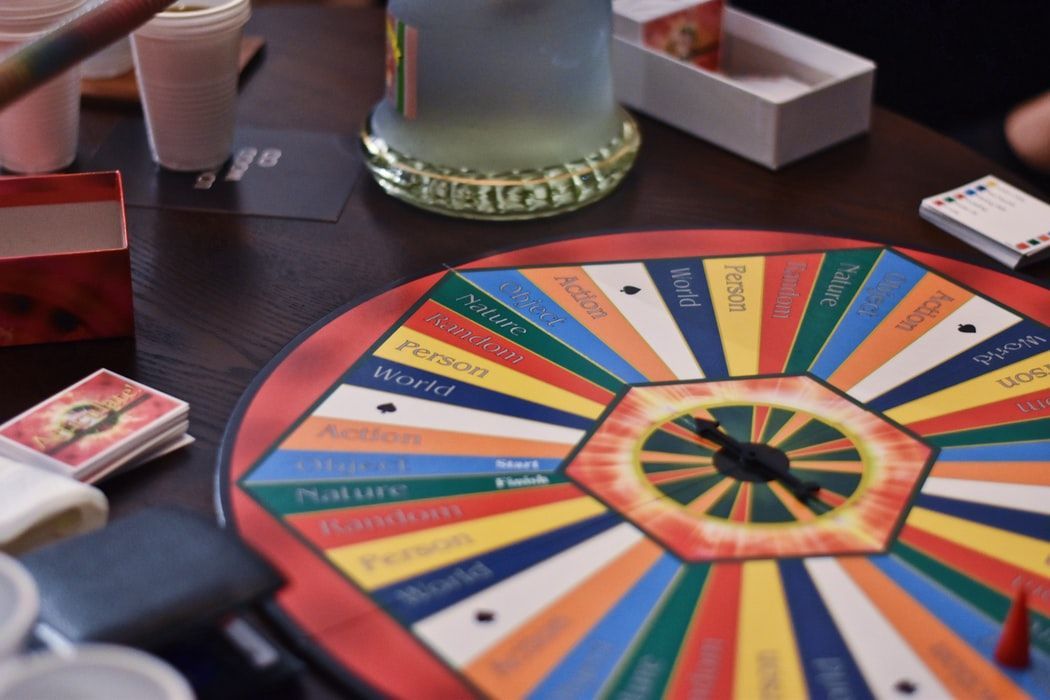You found our list of the best word games for adults.
Word games are fun activities that test vocabulary, spelling, and language skills. Examples include Hangman, Skribbl, and Crosswords. These games aim to ensure that teammates have fun, interact and unwind while improving communication skills.
These challenges are similar to vocabulary games, letter games, interactive activities for students, and quick games for the office.
This list includes:
- word games for groups
- spelling word games for adults
- simple word games
- writing games for adults
Here we go!
List of fun word games for adults
From I Spy to Words Within a Word to Scattergories, here is our list of fun word games and activities.
1. Words Within a Word
Words Within a Word is one of the best word games for groups because it encourages teammates to brainstorm and share ideas.
To play:
- Share pieces of paper and pencils with teammates.
- The teammates will choose a host for the game.
- The host will select 15 to 20 long words.
- The host will share the words one at a time with the players.
- The players have 30 to 60 seconds to find as many words as possible within the given word and write them on paper. For example, the word “Explanation” has the words “Planet,” “plane,” “tin,” and “pin.”
- The player with the most words within the allocated time wins the round.
- The game will continue this way until the players have used up all the words.
This game is a fun way for teammates to test their language skills and develop their spelling skills. You can also organize this activity online by encouraging teammates to use the chat box. This activity can serve as an icebreaker activity for online meetings or a fun game during team get-togethers.
2. Sparkles
Sparkles is a fun word game that improves teammates’ spelling skills. In this activity, the players will sit in a circle. The first player will say a word out loud, then the second player will spell out the first letter of the word while the third player spells out the second letter. The game will continue until the last letter of the word is spelled out. The next player will yell “sparkles” and get out of the game.
The players will then begin spelling another word, and whosoever yells “sparkles” at the end of the word is out of the game. This game broadens teammates’ vocabulary and ensures that teammates collaborate. Whichever player also spells out the wrong letter is out of the game. To make this game as exciting as possible, challenge the players with difficult words that may be difficult to spell.
3. Common Quality
Common Quality is one of the best verbal games for teammates because it teaches players to connect specific descriptions to words. In this activity, the first player will say a word and a characteristic that the word has. For example, apples are green. The next player will then say a word with the same attribute or characteristic. For instance, vegetables are also green and healthy.
The next players will then use the next attribute to describe another word. The game will continue in this fashion until each player has several turns.
4. Hangman
Hangman is a fun and exciting game where teammates solve word puzzles to escape the hangman’s noose.
To play:
- Split the teammates into small groups of four to six.
- Choose a player to create words.
- The wordmaster writes down dashes on a board to represent each letter of a word.
- The teammates will need to guess the word by guessing the letters.
- The wordmaster will write each correct letter as it appears within the word.
- If a player guesses incorrectly, then the wordmaster draws a part of the hangman’s noose
- The game will continue in this fashion until players guess the word or the wordmaster completes the hangman.
This game is one of the best spelling word games for adults because it is easy to play and exciting. You can also play this game on any video conferencing platform using the whiteboard feature.
5. I Spy
I Spy is a classic word game that boosts teammates’ vocabulary and improves language. In this game, a player will identify an item and give hints for teammates to guess. For example, players will say, “I spy with my little eye something beginning with H.” Then, the teammates will take turns guessing the word.
Players have 60 seconds to get the answer right, or another player will take a turn. This activity is simple to organize, fun, and easy to play. You can also organize this activity via video call for teammates. I Spy counts as a word game because it encourages participants to associate descriptive words with nouns.
6. Scattergories
Scattergories is one of the most simple word games for adults. This game expands players’ vocabulary and is a fun way for teammates to engage and interact.
To play:
- Choose 12 categories. For example, fruits, names, and animals.
- The players will randomly choose a letter, and each teammate has 60 seconds to fill in words starting with the given letter in each category. For example, if the teammates choose the letter “S,” they may fill in the given categories with “Strawberries,” “Sonia’, and “Snake.”
- Each teammate who fills each category within the allocated time gets three points.
- Players do not get any points for an answer if another player also comes up with the same response.
- At the end of the game, the player with the highest point wins.
- Teammates can also play this game online on any video conferencing platform or applications like Slack or Discord.
Here is a collection of team building Scattergories lists.
7. Crosswords
Crosswords is a simple and entertaining game where teammates match letters in a grid to make words. Teammates can play this game individually or in teams for free online.
The teammates can set a timer for 15 to 20 minutes, and each team must find all the words in the grid within the allocated time. The first team to cross all the words wins the game. To play this activity online, you can use a fillable crossword website or share a puzzle onscreen during a conference call and turn on the annotation feature so that participants can fill in letters.
This game is an exciting way for teammates to unwind, get to know each other, and develop friendships.
Here is a free online crossword game.
8. My Story
My story is one of the most interactive games for adults. This game allows teammates to build stories or create novel ideas from scratch.
To play:
- Split the teammates into groups.
- Each group will get a set of words. For example, “Miami,” “wealth,” “sadness,” and “future.”
- Each team member must write a short two-sentence story with one of the words.
- The group members will then combine stories and ensure that it flows.
- The best story wins.
This game is an easy way for teammates to show their creativity, collaborate and share ideas. To make this game even more exciting, the teammates can make their stories as funny and outrageous as possible.
9. Random Word Game
Random Word Game is a fun and easy game that challenges teammates’ knowledge. In this game, players must come up with words starting with the last letter of a teammate’s word.
To play:
- The players will sit in a circle.
- The first player will choose any category. For example, fruits.
- The first player must name any word within the selected category. For example, “banana.”
- The next player must then call any other fruit beginning with the last word of the given word. For example, “apple.”
- The game will continue in this fashion until all the teammates get several turns.
- The teammates have only 30 seconds to come up with words.
- Any player who cannot come up with a word within the allocated time is out of the game.
This game teaches teammates to think and brainstorm under pressure and helps test teammates’ knowledge on a variety of topics and categories.
For inspiration, here is a random word generator.
10. Rhyming Word Game
Rhyming Word Game is a fun activity that promotes learning and encourages teammates to interact with each other. In this activity, the first player will say a word, and the other teammates will take turns saying words that rhyme.
If the teammates run out of rhymes, the next player will come up with a new word, and other players will find matching rhymes. The game will continue in this fashion for several rounds. This game is a fun way to test teammates’ knowledge and challenge players to learn new words.
Pro tip: To make the game extra funny and challenging, teammates might purposely use words that are difficult to rhyme.
11. The Alliteration Game
The Alliteration Game is a fun and engaging game that requires teammates to create complete sentences, all beginning with a chosen letter.
To play:
- The teammates will sit in a circle.
- The players will play in alphabetical order. For example, the first player will choose the letter “A,” the second player the letter “B,” and the third player the letter “C.”
- Each player will create a full sentence using alliterations with their given letter. For example, Allison Ate All the Angel’s Apples
- The game will continue in the fashion until each player has had a turn.
- The players must switch positions to play a new round.
- Players who can’t use their given letter can skip to the next one.
- Each player can only skip twice.
This game is a great way to spark conversations among teammates and encourage employees to interact with each other. This is one of the best activities for team building or an icebreaker activity for online meetings.
12. Scrabble
Scrabble is a classic word board game where teammates get words for creating new words. This activity is an easy way to encourage team building and foster team bonding.
To play:
- Get a Scrabble board with all of its components.
- Get a dictionary in case teammates need to confirm words.
- The players will choose an order in which to play.
- Shake the bag of letters to mix up the letters, then each player will pick a letter.
- The players will continue in this fashion until each player has drawn seven letters.
- Next, each player will arrange their letters on a letter.
- The first player will create a word on the board horizontally or vertically.
- Each letter has score points. The player will accumulate points for each complete word and note them down.
- Players will draw new tiles for each tile used up during a turn. For example, if a player uses up five tiles for a word, then can only draw five more tiles from the bag at the end of their turn.
- Players can create new words from other teammates’ words on the board.
- The game will continue in this fashion until the board is full.
The teammates can refer to the dictionary if they have any confusion about a teammate’s word. This activity is a fun way for teammates to develop their spelling skills and learn the meaning of words. In addition, since players must make words around the letters already on the board, this activity encourages employees to build upon teammates’ ideas instead of creating solo.
13. Four Pictures One Word
Four Pictures One Word is an exciting online game that challenges teammates to brainstorm and pay attention to detail. In this game, the players will get four pictures that can be described with one word. Then, the players must guess the word right within a given time.
Participants can play individually or in teams. Teammates have 30 to 60 seconds to guess the word before the game passes it on to the next player or team. This activity broadens teammates’ vocabulary and helps improve spelling skills.
Here is a free Four Pictures One Word website.
14. Skribbl
Skribbl is a fun game that encourages players to cooperate and work together to solve word puzzles.
To play:
- Access the Skribbl website.
- Choose between three given words to draw.
- Split the teammates into groups.
- Each group will choose a player to draw.
- The player will draw the given word using the tools available on the screen.
- The teammates must guess the word the player is drawing within 60 to 80 seconds.
- The game will continue in this manner until each group has had several turns.
- The group with the highest points wins the game.
This game teaches teammates to collaborate and follow instructions from colleagues or superiors. This activity is also the perfect opportunity for teammates to engage and get to know each other.
Here is the Skribbl website.
15. The Word Spell
The Word Spell is a fun activity that teammates can use to develop their spelling skills. For this game, teammates will need a dictionary, a sheet of paper, and a pencil or pen.
To play:
- The teammates will choose a host to oversee the game.
- The teammates will choose an order in which to play.
- The host will randomly select a word in the dictionary and read out its definition without saying what the word is.
- The first player will guess the word and spell it.
- The host may offer clues through synonyms or by telling the player how many letters the word has.
- The game will continue in this fashion until each player has had several turns.
This activity challenges teammates to learn and helps broaden their vocabulary. This activity is a fun icebreaker for work and is a great way to ensure team bonding and interaction. You can also play this game online by typing the word’s definition and sharing it with attendees, and players must guess and send the word via the comment box. The first player to get the answer right wins the round.
16. Comic Story Telling
Comic Story Telling is one of the best writing games for adults because it allows folks to show off their storytelling skills and have fun. In this activity, teammates will need a notepad and pens.
To play:
- Sit in a circle.
- The first player will write a line of a funny story and pass the notepad to the next player.
- The next player will continue the story with another funny line.
- The game will continue in this fashion until the players find a satisfying and funny end to the story.
This activity will cause loud bouts of laughter, which will help teammates unwind, interact and bond with each other. This activity is also an excellent opportunity for teammates to share fun ideas and work together.
Conclusion
Word games help test teammates’ verbal, language, and spelling skills which may be necessary at work. These games also allow teammates to discuss, interact and get to know each other. Most of these activities are very easy and require little to no guidance.
For more resources, check out communication games, guessing games, and question games.
FAQ: Word games
Here are some frequently asked questions about fun word games.
What are some fun word games for adults in English?
Some fun word games for adults in English include The Alliteration Game, Random Word Game, and The Word Spell.
How do you play word games as an adult?
To play word games as an adult, choose fun verbal games that test and challenge your spelling, vocabulary, and language skills. Choose a group of friends or teammates to play with and ensure that you have a fair point system to select winners easily. It is also essential to have plenty of paper and pens handy to play these games. You can play these games in person or online using the screen sharing feature, whiteboard feature or have responses sent via the chat box on your video conferencing software.
If you want to improve your writing, maybe it’s time to ditch all the writing books and podcasts and play some word games instead.
Yes, seriously! Word games and writing games are great ways to develop your vocabulary, to help you think more deeply about words, to have fun with story and structure, and to get a lot of fun out of writing.
But games can be a great way to:
- Develop your vocabulary
- Help you think more deeply about words
- Become more fluent in English (if it’s a foreign language for you)
- Invent and develop characters
… and much more.
After the list of 50 writing games, I’ve given you a top ten that I think are particularly great for kids who want to practice their writing skills. Many of the other games are suitable for children, too, so by all means try out other games as a family if you want to.
Of course, there are loads of online games (and quizzes and tools) that you can use to improve your writing skills, and I will be talking about some of the best of those. But there are also lots of tried-and-tested classic games that you can play with pen and paper, or using cards and dice … and we’ll be taking a look at those first.
5 Pen and Paper Word Games
I’ll start with the simplest games: pen and paper ones that you can play pretty much anywhere, so long as you have a pen.
All of these are suitable for children, and some (like crosswords) are enjoyed by many adults too.
#1: Hangman (2+ players)
Hangman is a classic word game for two players. One player thinks of a word and writes down dashes to represent the number of letters. The other guesses letters of the alphabet. Correct letters are inserted into the word; incorrect letters result in another segment of the “hangman” being drawn.
This is a great game for developing spelling and vocabulary. If you’re playing it with small children, you can do it without the perhaps rather unpleasant “hangman” element, and just count how many guesses each player takes!
#2: Crosswords (1 player)
A crossword is a grid of white and black squares, where each white square is one letter of a word. The words intersect. You can find crosswords in many newspapers and magazines (on all sorts of subjects), and you can buy booklets and books full of them. Some crosswords are “cryptic”: great if you like brainteasers. Others have more straightforward clues.
Crosswords are great if you want to learn new words and definitions, or (at the cryptic end of the scale) if you enjoy playing with words and language. Simple ones are suitable for fairly young children, with a little help.
#3: Word searches (1 player)
A word search has a grid (often 10×10 or more) filled with letters, and a number of words written alongside or beneath the grid. The person completing the word search needs to find those words within the grid.
Most word searches are easy enough for children, though younger children will struggle with backward and diagonal words. They’re a good way to get used to letter patterns and to improve spelling – and because word searches rely on matching letters, even children who can’t read well will be able to complete simple ones.
#4: Consequences (2+ players, ideally 4+)
This is a fun game with a group of people, as you get a wild and wacky mix of ideas. Each player writes down one line of a story and folds the paper over before passing it around the table to the next player. The very simple version we play has five lines: (1) A male name, (2) The word “met” then a female name, (3) “He said …” (4) “She said …” (5) “And then …”
Once all five stages are complete, the players open out the papers and read out the results. This can be great for sparking ideas, or as a way to encourage reluctant writers to have a go.
#5: Bulls and Cows (2 players)
This game, which can also be called “Mastermind” or “Jotto” involves one player thinking up a secret word of a set number of letters. The second player guesses a word; the first player tells them how many letters match in the right position (bulls) and how many letters are correct but in the wrong position (cows).
Our five year old loves this game, and it’s been a great way to develop her spelling and handwriting as well as logical thinking about which letters can or can’t be the correct ones after a few guesses.
10 Board and Dice Games
These are all games you can buy from Amazon (or quite probably your local toyshop). They’re fun ways to foster a love of writing within your family, or to share your enjoyment of words with your friends.
#1: Scrabble (2+ players)
A classic of word games, Scrabble is a game played with letter tiles on a board that’s marked with different squares. (Some squares provide extra points.) Letters have different points values depending on how common they are. The end result of scrabble looks like a crossword: a number of words overlapping with one another.
If you want to develop your vocabulary (particularly of obscure two-letter words…) then Scrabble is a great game to play. It’s suitable for children too, particularly in “Junior” versions.
#2: Boggle (2+ players)
This is less well known than Scrabble, but it was one I enjoyed as a child. To play Boggle, you shake a box full of dice with a letter on each side, and the dice land in the 4×4 grid at the bottom of the box. You then make as many words as you can from the resulting face-up letters.
Again, this is a good one for developing vocabulary – and it can be played by children as well as by adults. You need to write down the words you come up with, which can also be good for developing handwriting.
#3: Pass the Bomb (2+ players)
It’s very simple to play: you deal a card for the round pass a “bomb” around the table and when it goes off, the person holding it loses. Before you can pass the bomb on during your turn, you need to come up with a word that contains the letters on the card.
It’s a fun family or party game, and can work well with a wide range of ages. It’s a great way to help children think about letter patterns, too, and to develop vocabulary and spelling.
#4: Story Cubes (1+ players)
There are lots of different versions of these available, and they all work in a similar way. The open-ended game has a set of cubes that you roll to create ideas for a story that you can tell along with the other players. If you prefer, you can use them to come up with stories that you’re going to write on your own.
There are lots of different ways you can use them: as writing prompts for a school class or group, to make up a bedtime story together with your children, for getting past your own writers’ block, or almost anything you can think of.
#5: Apples to Apples (2+ players)
Apples to Apples has red cards (with the name of a person, place, thing, etc) and green cards (with two different descriptions): the player with a green card selects one of the descriptions, and others have to choose a card from their hand of red cards. The judge for that game decides which red card best matches the description.
If you want to develop your vocabulary (or your kids’), this could be a fun game to play. There are lots of expansions available, plus a “junior” version with simpler words. (If you’re playing with adults, you might also want to consider Cards Against Humanity, a decidedly not-kid-friendly game that works in a very similar way.)
#6: Letter Tycoon (2+ players)
In this game, you have a hand of 7 cards which you can use in conjunction with the 3 “community cards” to create a valuable word. It’s a more strategic game than some others, with aspects of finance (like patents and royalties) involved too – if you’re a budding tycoon, you might really enjoy it.
Because not all the game strategy depends on simply being good with words, it doesn’t matter if some players have a larger vocabulary than others. It’s suitable for children, too, so you can play it as a family game.
#7: Dabble (2+ players)
Dabble is a family-friendly game where you compete with other players to be the first to create five words (of 2, 3, 4, 5 and 6 letters) using your 20 tiles. It’s very simple to get the hang of … but coming up with the words might be more challenging than you expect!
If you enjoy Boggle or Scrabble, you’ll probably have fun with Dabble. It’s a great way to develop both spelling and vocabulary, and to have fun with words.
#8: Upwords (2+ players)
Upwords is like 3D Scrabble: you can stack tiles on top of other tiles to create new words. The board is smaller than a Scrabble board (and doesn’t have double and triple word score squares) so it’s not as complex as it might initially sound.
Like similar games, it’s a great one for building vocabulary and for developing your spelling. It’s suitable for kids, too, so it could be a great game for the whole family.
#9: Tapple (2+ players)
Tapple has a wheel, with most of the letters of the alphabet on it, and lots of different “topic cards” that cover 144 different categories. There are lots of different ways you can play it – the basic rules are that each player has to think of a word that fits the topic within 10 seconds, but that word can’t start with a starting letter that’s been used previously.
While small children might find it a bit too challenging or frustrating, due to the short time limit, this could be a great game for older children looking to extend their vocabulary. All the categories are suitable for kids.
#10: Last Word (2+ players)
In Last Word, players have to come up with answers to “Subject” and “Letter” combinations, racing to get the last word before the buzzer. It works a bit like a combination of “Tapple” and “Pass the Bomb”.
You can easily play it with a large group (there are tokens for up to 8 players, but you could add more without affecting the gameplay). It’s a great way to develop vocabulary and, to some extent, spelling.
5 Roleplaying Games
While my geeky tendencies have been reined in a bit since I had kids, I’ll admit I have a great fondness for roleplaying games: ones where you come up with a character (often, but by no means always in a magic-medieval setting) and play as them. These are some great ones that you might like to try.
#1: Dungeons and Dragons (3+ players)
Although you might never have played Dungeons and Dragons, I’m sure you’ve heard of this classic roleplaying game that’s been around since 1974 and is now onto is 5th edition. It takes rather longer to get to grips with than a board or card game: to play, you need a “Dungeon Master” (essentially the storyteller of the game) and at least two players (who each control a character), plus rulebooks and a lot of different dice.
It’s a great game for developing the “big picture” aspects of writing, like the ability to construct a plot and a story (if you’re the Dungeon Master) and the skills involved with creating a character, giving them a backstory, and acting “in character” as them (if you’re one of the players).
#2: Amazing Tales (1 parent, plus 1 or 2 children)
This is a kid-friendly RPG aimed at parents who want to create a story with their child(ren). It’s like a very simple version of Dungeons and Dragons, and has straightforward but flexible rules. You can play it with a single six-sided dice – though it’s better if you have four dice (with six, eight, ten and twelve sides).
If you want to encourage your child’s creativity and have fun creating stories together, this is a wonderful game to play. The rulebook contains lots of ideas and sample settings, with suggested characters and skills … but you can come up with pretty much any scenario you like.
#3: LARP (Live Action Roleplay) (lots of players)
Over the past decade or so, LARP has become a bit more mainstream than it once was. It’s short for “Live Action Roleplay” … which basically means dressing up as your character and pretending to be them. It’s a bit like Dungeons and Dragons crossed with improv drama.
The nature of LARP is that it needs quite a lot of people, so unless you have loads of friends to rope in, you’ll want to join an organised LARP – there are lots out there, covering all sorts of different themes, from traditional fantasy ones to futuristic sci-fi ones. Some are suitable for children, but do ask event organisers about this. They won’t necessarily involve any sort of writing, but can be a great way to explore characters and dialogue.
#4: MUDs (lots of players)
MUDs, or “multi-user dungeons” have been around since the early days of networked computing in the ‘70s, and are the forerunners of games like Fortnite and World of Warcraft. They’re now distinctly retro-looking text-based online games, where players create a character and interact with other characters and the world.
Like other types of roleplaying game, they’re a great way to practice storytelling and character-development skills. They also involve a lot of writing – so they can be useful for things like vocabulary and spelling. Some are suitable for children, but as with anything online, do ensure your children know how to be safe (e.g. by not giving out their full name, address, etc).
#5: Online Forum Games / Forum Roleplaying (2+ players)
Some fan communities write collaborative fanfiction through forums (here’s an example), with different people posting little pieces as different “characters” to continue a story. These can be quite involved and complex, and they can be a great way to learn the skills of telling a long, detailed story (e.g. if you’re thinking of writing a novel).
They’ll probably appeal most to writers who are already producing fanfiction on their own, and who have a fair amount of time for the back-and-forth required for forum roleplaying. Again, if your child wants to get involved with this type of roleplaying, do make sure you monitor what they’re doing and who they’re interacting with.
10 Word Games You Can Play on Your Phone
These days, many writers are more likely to have their phone to hand than a pen and paper … and to be fair, there’s nothing wrong with that. You can easily make notes on a phone, whether by tapping them in or by recording them. If you find yourself with a bit of time on your hands, why not try one of these writing-related games?
Note: all of these are free to download, but most allow in-app purchases, and you may find you need to make a purchase to get the most out of them.
#1: Bonza Word Puzzle
This game is a bit like a deconstructed crossword: you get bits of the puzzle and you drag them together to form words that will all match with the clue. If you’re a fan of crosswords and want something a bit different, you might just love it.
It’s a great way to think hard about letter patterns and how words are put together, so it might be a good game for older children who’re looking to develop their spelling and vocabulary, too.
#2: Dropwords 2
Dropwords 2 (a rewrite of the original Dropwords) is a word-finding puzzle where letters drop from the top of the screen: if you remember Tetris, you’ll get the idea. It’s a bit like Scrabble or Boggle, and you have to race the clock to make letters out of the words on the screen.
With six different modes (“normall”, “lightning”, “relax”, etc), it’s suitable for children and for people who are learning English, as well as for those wanting to really challenge their vocabulary skills.
#3: Spellspire
Spellspire is a fantasy-style game where you select letters from a grid to create words: the longer the word, the bigger the blast from your magic wand! You can kill monsters, buy better equipment, and make your way to the top of the Spellspire.
If your kids aren’t very motivated to practice their spelling, this could be a great game for them. (Or, let’s face it, for you!) You can also choose to play it against your Facebook friends, adding a competitive element.
#4: TypeShift
This is a relatively simple game that lets you create words from letters arranged on different dials. There are a couple of different ways you can play: by trying to use all the letters on the dials at least once to create words, or by tackling the “Clue Puzzles”, which are a bit like crossword clues.
Again, if you want to develop your spelling and vocabulary, this is a straightforward game that you can use to do so. You can buy extra puzzle packs at a fairly reasonable price, if you find that you want to play it a lot.
#5: Wordalot
This crossword app uses pictures rather than written clues, which is a fun twist. You can use coins to get hints (you can earn these through the game, or purchase them with real money).
If you enjoy doing crosswords but want something a bit different, give this one a try. You might find that as well as helping you develop your spelling and vocabulary, it’s a great way to develop your lateral thinking as you puzzle out the clues.
#6: WordBrain
This game is another one where you have to find hidden, scrambled words within a grid. There are loads of different levels (1180!) and so this could keep you busy for a long time. You can purchase hints – this could potentially see you clocking up quite a spend, though.
All the words are appropriate for children (though some are tricky to spell), so your kids might well enjoy this game too, as a way to develop their spelling and vocabulary.
#7: Ruzzle
Ruzzle works like Boggle, with a 4×4 grid of letters that you use to make words (the letters must be adjacent to one another). You can play it against friends, or simply against random players.
Like the other apps we’ve looked at, it’s a good one for developing your vocabulary and spelling. Some players said it included too many ads, so this is something to be aware of if you plan to use the free version rather than upgrading.
#8: WordWhizzle Search
This is a word search type game with loads of different levels to play. If you enjoy word searches, it’s a great way to carry lots around in your pocket! You can play it alone or with Facebook friends. It’s easy to get to grips with, but the levels get increasingly tricky, so you’re unlikely to get bored quickly.
As with other apps, this is a great one for developing your spelling and vocabulary. Each level has a particular description (words should match with this), so you have to avoid any “decoy” words that don’t match.
#9: 7 Little Words
This game works a bit like a crossword: each puzzle has seven clues, seven mystery words, and 20 tiles that include groups of letters. You need to solve the clues and rearrange the letter types so you can create the answers to the mystery words – so it’s also a bit like an anagram.
There are five different difficulty levels (“easy” to “impossible”) and each game is quick to play, so this could be a good one for kids too. Again, it’s a great way to develop vocabulary and spelling.
#10: Words With Friends
This classic word-building game is hugely popular, and you can play against your Facebook or Twitter friends, or against a random opponent. It works just like Scrabble, where you have seven letter tiles and add them to a board.
You can chat with the opponent in a chat window, so do be aware of this if you’re allowing your kids to play. The game is a great way to develop vocabulary and spelling, and you can play it fairly casually because there’s no time limit on your moves.
10 Word Games You Can Play in Your Browser
What if you want a writing-related game you can play while taking a break at your computer? All of these are games that you can play in your browser: some involve a lot of writing and are essentially story-telling apps, whereas others are essentially digital versions of traditional pen and paper games.
Unless otherwise noted, these games are free. With some free browser games, you’ll see a lot of ads. If this annoys you, or if you’re concerned that the ads may be unsuitable for your children, you may want to opt for premium games instead.
#1: Wild West Hangman
This is a digital version of Hangman, which we covered above. You choose a category for words (e.g. “Countries” or “Fruits And Vegetables”) and then you play it just like regular Hangman.
It’s simple enough for children – but it only takes six wrong guesses for your cowboy to be hanged, too, so it could get frustrating for younger children.
#2: Word Wipe
In Word Wipe, you swipe adjacent tiles (including diagonals) to create words, a bit like in Boggle. The tiles fall down a 10×10 grid (moving into the blank spaces you’ve created when your word disappears from the grid) – your aim is to clear whole rows of the grid.
Since the easiest words to create are short, simple ones, this is a great game for children or for adults who want to get better at spelling.
#3: Sheffer Crossword
As you might expect, this is a crossword game! There’s a different free puzzle each day, and you can choose from puzzles from the past couple of weeks. It looks very much like a traditional crossword, and you simply click on a clue then type in your answer.
The clues are straightforward rather than cryptic, though probably not easy enough to make this a good app for children or for English learners. If you’re a fan of crosswords, this will definitely be a great way to develop your vocabulary, though.
#4: Twine
Twine is a bit different from some of the other games we’ve looked at: it’s a tool for telling interactive stories (a bit like the old “Choose Your Own Adventure” books, or a text-based adventure game). You lay out your story as different cards and create connections between them.
If you want to experiment with interactive fiction, this is a simple, code-free to get started – as reviewer Kitty Horrorshow puts it, “if you can type words and occasionally put brackets around some of those words, you can make a Twine game”. It’s a great way to deepen your understanding of story, plot and narrative.
#5: Storium
Like Twine, Storium is designed to help you tell stories … but these stories are written in collaboration with others. (There’s a great review, with screenshots, here on GeekMom.) You can either join a story as a character within it, or you can narrate a story – so this is a great game for building lots of different big-picture fiction-writing skills.
It’s suitable for teens, but probably involves a bit too much writing for younger children. If you’d like to write fiction but the idea of creating a whole novel on your own seems a bit overwhelming, or if you enjoy roleplaying-type games (like Dungeons and Dragons), then you might just love Storium.
#6: Words for Evil
This game combines a fantasy RPG setting (where you fight monsters, get loot, gain levels and so on), with word games to play along the way. It could be a good way to encourage a reluctant young teen writer to have fun playing with words – or you might simply enjoy playing it yourself.
The word games work in a very similar way to Word Wipe, so if you found that game frustrating, then Words for Evil probably isn’t for you!
#7: First Draft of the Revolution
This game is an interactive story, told in the form of letters (epistolary). It comes at writing from a much more literary angle than many of the other games, and if you’ve studied English literature or creative writing, or if you teach writing, then you might find it particularly interesting.
The graphics are gorgeous – playing the game is like turning the pages of a book. To play First Draft of the Revolution, you make choices about how to rewrite the main character (Juliette’s) draft letters – helping you gain insight into the process of drafting and redrafting, as well as affecting the ongoing story.
#8: Writing Challenge
Writing Challenge can be used alone or with friends, creating a collaborative story by racing against the clock. You can use it as an app on your phone, as well as on your computer, so you can add to your stories at any time.
If you struggle to stay motivated when you’re writing, then Writing Challenge could be a great way to gamify your writing life – and potentially to create collaborative works of fiction.
#9: Plot Generator
Plot Generator works a bit like Mad Libs: you select a particular type of story (e.g. short story, movie script, fairytale) then enter a bunch of words as prompted. The website creates the finished piece for you. There are also options for story ideas (essentially writing prompts), character generators, and much more on the site.
If you’re stuck for an idea, or just want to play around a bit, Plot Generator could be a lot of fun. Some of the options, like Fairy Tale, are great to use with young children – others may not be so suitable, so do vet the different options first.
#10: The Novelist ($9.99)
The Novelist follows the life of Dan Kaplan, a struggling novelist who’s also trying to be a good husband and father. You can make choices about what Dan should do to reach his goals in different areas of his life – and the decisions you make affect what happens next in the game. You are a “ghost” in the house, learning about and influencing the characters.
While there’s not any actual writing involved in the game, it could be a thought-provoking way to explore how writing fits into your own life.
10 Games to Help You Learn to Type
Typing might seem like an odd thing to include on a list of writing games. But so much of writing involves being able to type – and if you’re a slow typist, you’ll find that your fingers can’t keep up with your brain! While most people find that their typing does naturally improve with practice, these games are all quick ways for you (or your kids) to get that practice in a fun way.
Obviously, all of these games should help to improve typing skills: those which involve whole words may also help with spelling and vocabulary. Unless otherwise mentioned, they’re free.
#1: Dance Mat Typing
This game is designed to teach children touch type (type without looking at the keyboard). It starts off with Level 1, teaching you the “home row” (middle row) keys on the keyboard. Other letters are gradually added in as the game progresses.
It’s very much aimed at kids, so teens and adults may find the animated talking goat a bit annoying or patronising! Unlike many other free games, though, it doesn’t include ads.
#2: Spider Typer
This typing game took a while to load for me: you too many find it’s a bit slow. In the game, you type the letters that appear on chameleons that are trying to catch a spider (the chameleons disappear when you hit their letter). The spider keeps rising up into a tree, and if it safely gets there, you move on to the next level.
It’s suitable for kids, and starts off very easy with just letters: if you set it to a harder difficulty, you need to type whole words.
#3: NitroType
This is a competitive typing game where you race a car against friends (or total strangers) by typing the text at the bottom of the screen. It’s a good one for practicing typing whole sentences, including punctuation – not just typing letters or words.
Older children might enjoy it, and any adults with a strong competitive streak! You can compete as a “guest racer”, or you can create an account and login so you can level up and gain rewards like a better car.
#4: TypeRacer
TypeRacer is similar to NitroType: you control a racing car and the faster you type, the faster your car moves. You can practice on your own, enter a typing race, or race against your friends if you prefer.
If you create an account and login, other users can see your username, score, average speed and so on – and they can also send you messages. This could potentially open you up to receiving spam or unwanted communications, so do be aware of this, particularly if you’re allowing your child to play.
#5: The Typing of the Ghosts
In this game, you destroy ghosts by typing the word on them. The graphics are pretty rudimentary, though it is a free game and a good way to practice quickly typing words. It’s suitable for children, and the sound effects (there’s a noise for every letterstroke) may appeal to kids.
You don’t need to create an account or login: you can simply start playing straight away.
#6: Typing Chef
In this game, you type cooking-related words (usually types of equipment). It involves single words and a few double words with a space between at the early levels.
There’s nothing particularly unusual about this game compared with others, though it wasn’t so ad-heavy as some and doesn’t require any registration. It’s good for teaching words and phrases, but not for helping you to learn to type whole sentences.
#7: TypeTastic
This is a fun typing game aimed at young kids, so it starts with the fundamentals. You start by building a keyboard from letter blocks, then learn how to spot letters on the keyboard quickly before learning where those letters are located.
Teachers or parents might be interested in reading about why the game starts with mapping the keyboard. The interface and graphics are pretty good, given that it’s a free game, and it’s designed specifically with young children in mind.
#8: Typer Shark! Delux
This is a free typing game, where you’re a diver exploring the seas. You can choose from different difficulty levels, and – in a mechanic that’s probably by now quite familiar if you’ve played any of the other typing games – you get rid of creatures like sharks by typing the word written on them.
Again, this can help you with your typing speed and accuracy. I found it was a bit slow to load, but it’s not full of ads like some other games.
#9: Typing Attack
In this game, you’re a spaceship, facing enemy spaceships – each with a word written on them. I expect you can guess what you need to do: type the word correctly to destroy the spaceship. Some words are shorter, some longer, and as with other games, there are multiple difficulty settings.
You’ll need to watch an ad before the game loads, which can be annoying, and means that it isn’t necessarily suitable for children.
#10: The Typing of the Dead: Overkill ($14.99)
This game is definitely aimed at adults rather than kids, because it’s a bit gory. It also costs $14.99, so it’s probably one that’ll suit you best if you’re really keen to improve your typing speed – perhaps you do transcription, for instance, or you’re a freelance writer.
To play the game, you type the words that appear in front of the enemies and monsters: each type you type a letter correctly, you send a bullet at them. If you like horror games and films, it could be a fun way to learn to type faster – but it won’t necessarily improve your accuracy with whole sentences.
10 Word Games that Are Particularly Suited to Kids
While I’ve tried to indicate above whether or not the games are suitable for kids, I wanted to list the ten that I’d particularly recommend if you want to help your children get a great start as budding writers.
Several of these are games I play with my five-year-old already; others are games I’m really looking forward to using with her and my son as they get older. I won’t repeat the full descriptions: just scroll back up if you want those.
#1: Word searches (pen and paper) – you can buy whole books of these, or print off free ones. Older kids might have fun creating their own for their friends or siblings.
#2: Bulls and Cows (pen and paper) – you can play this with just a pen and paper (or if you’ve got a really good memory, with nothing at all).
#3: Boggle (board game) – this is simple enough for quite young children to get the hang of it: my five-year-old enjoys playing it with her Granny.
#4: Story Cubes (dice game) – your child can use these on their own to come up with ideas for a story, or you could use them with a group of children – e.g. in a classroom or as part of a club.
#5: Amazing Tales (roleplaying) – this child-friendly RPG is a great way to introduce big-picture storytelling skills, particularly developing a character.
#6: Spellspire (phone app) – a fun spelling/word-creation game your child can play on your phone (and probably a bit more educational than yet another game of Angry Birds).
#7: Wild West Hangman (browser game) – if your child likes hangman but you don’t always have the time to play it with them, this is a good alternative.
#8: First Draft of the Revolution (browser game) – if your teen is interested in writing and/or the French revolution, they might really enjoy this intriguing game based around redrafting letters.
#9: Dance Mat Typing (typing game) – this game from the BBC is high-quality, and designed to appeal to young children. It teaches good typing practice from the start, by explaining correct finger placement on the keys.
#10: TypeTastic – this is another typing game aimed at young children, and this one starts with putting together a keyboard – a great place to begin.
—
Do you have any favourite writing games – of any type? Share them with us in the comments.
When’s the last time you picked up a pen and did a little drawing? Maybe it has been years since you expressed your creativity with pen and paper, or maybe you’ve attended an increasingly popular Sip and Paint class. Either way, chances are that you could do with a little more doodlin’ in your life!
Expressing your artistic side has plenty of benefits that carry over into your day and even your work. Studies have shown that having a creative outlet reduces stress, supports innovation and encourages problem solving. But the most important benefit of drawing is simply that it’s fun!
You may be wondering how to find time to draw considering your busy schedule. The answer, as always when trying to make change is to start small! A really easy, quick and fun way to start drawing again is by playing Pictionary.
Pictionary is a game where you draw a word and your friends try to guess what it is. The game’s rules are very simple and learning how to play Pictionary is easy too.
What you need to play Pictionary
The only things you need to play Pictionary are: a pen, paper, and a list of words. Luckily for you, we’ve provided a list of words below that are perfectly suited for getting started. You just need to scrounge up that pen and paper (and your creative side).
Playing Pictionary on Brightful
Want an even easier way to play? Today, you don’t even need a pen and paper to play this classic drawing game. Head on over to Brightful Meeting Games and play Draw It! It’s quick and easy to set up an online game room for it, and all everyone needs to play is a computer, tablet, or smartphone with an internet connection. Brightful takes care of everything: from the list of words to draw out to scorekeeping and timing every player’s turn.
Brightful games are designed to bring people closer together, regardless of physical distance. Playing Draw It with your colleagues over Zoom is a great way to have fun while at the same time promoting creativity and team-building with your remote colleagues.
What are some good Pictionary words?
Good Pictionary words are the ones that are a little bit challenging to draw, but are still common enough that everybody would know what they are. A word like apple is a bit too easily recognized, so it doesn’t pose much of a challenge. Another household item like toothpaste is a better Pictionary word because it requires some skill and creativity to draw! For a full list of good Pictionary words, scroll down.
How do I make Pictionary words?
The great thing about Pictionary words is that it can be anything! Just make sure you make it a common word that is the right level of difficulty to draw. A really great way to make Pictionary words is to use our Random Pictionary Word Generator. If you love making Pictionary words then you’ll enjoy being able to make your own Pictionary game. You can do this over at Brightful.
How do you win Pictionary?
Winning in Pictionary depends on how long you want to play for. For the traditional rules of Pictionary, you can check out our definitive Step by Step Guide on How to Play Pictionary. In general the rule is that the winner is the player (or team) with the most points after a few rounds of drawing and guessing.
Can you draw symbols in Pictionary?
Yes, symbols are allowed. While you can’t talk, draw letters, words or letters, you can still draw symbols ($, #, @).
Here’s a list of 107 Pictionary words to get you started on your path to becoming the next Picasso!
Easy Pictionary Words
Use these to warm up!
1. Bed
2. Furniture
3. Train
4. Rainbow
5. Paintings
6. Drawing
7. Cup
8. Plate
9. Bowl
10. Cushion
11. Sofa
12. Sheet
13. Kitchen
14. Table
15. Candle
16. Shirt
17. Clothes
18. Dress
19. Pillow
20. Home
21. Toothpaste
22. Guitar
23. Schoolbag
24. Pencil Case
25. Glasses
26. Towel
27. Watch
28. Piano
29. Pen
30. Hat
31. Shoes
32. Socks
33. Jeans
34. Hair Gel
35. Keyboard
36. Bra
37. Jacket
38. Tie
39. Bandage
40. Scarf
Medium difficulty Pictionary words
Getting a little bit hard…
41. Long underwear
42. Quicksand
43. Stomach ache
44. Vacuum cleaner
45. Swiss cheese
46. Cream cheese
47. Pizza crust
48. Bruise
49. Fog
50. Crust
51. Battery
52. Cereal
53. Blood
54. Moss
55. Thorn
56. Algae
57. Slug
58. Antenna
59. Butterfly wing
60. Parasite
61. Pollen
62. Asteroid
63. Family
64. Painting
65. Sketch
66. Wallpaper
67. Chandelier
68. Ketchup
69. Plane Ticket
70. Fruit Juice
71. Slippers
HARD Pictionary questions
Only attempt these if you’re a master of drawing!
72. Jello shots
73. Surprise party
74. Chili cheese dog
75. Mugshot
76. Moonwalk
77. Couch potato
78. Aurora Borealis
79. Leaning Tower of Pisa
80. Fairy
81. Hornets Nest
82. Immune System
83. Mushroom
84. The Sun
85. Zebra
86. Computer
87. Dust
88. Lawnmower
89. Moonwalking
90. Oyster crackers
91. Striped pajamas
92. Hiccups
93. Shaving cream
94. Giant zit
95. Breath mints
96. Snot bubbles
97. Body odor
98. Chicken pox
99. Crustacean
100. Froth
101. Plankton
102. Amoeba
103. Warmth
104. Softness
105. Dress Shoes
106. Shoeshine Kit
107. Chess Set
When you have a workload, you might feel stressed and pressured and cannot focus on office work. Sometimes, you might want to take a break and move around.
People in many offices don’t know each other, don’t recognize each other’s work, and don’t communicate well. If you work in the same office, you have few or no interactions with your coworkers.
Office games are the best way to increase employee engagement in corporate houses. This leads to better professional relationships. Teamwork and communication are improved.
The researchers found that if there are fun games in the workplace, employees feel like they are 89% more productive.
Employees learn valuable skills like time management, planning, and leadership by playing productive office games. The office can organize these games in a sense of employee training. Playing games always help you develop your professional and personal skills.
Here, I have mentioned some of the categories of fun office games. They are productive, and collaborative which you can play at your office or during office events.
Games for Fostering Communication and Bonding
It is possible to improve communication between the members of your team through various team-building activities, which will enhance team collaboration.
1. Baby Picture Guessing
When To Play – Break time
Another fun office games you can play at the office party is Baby Picture Guessing. In this game, you will learn about your colleagues personally. It would be better if everyone emailed their pictures so that even if they forget to bring a picture, you can download it from the email.
How to Play Baby Picture Guessing Game?
Step 1: Ask everyone to bring their baby pictures to the office event. Every picture should be of when they were one year old or younger. Also, participants should not show their photos to anyone else.
Step 2: Print all participant pictures in the same size (preferably large) on glossy papers.
Step 3: Number each picture and place all the photos on the wall or board
Step 4: Place a card or piece of paper with the name of the people whose pictures are on display.
Step 5: Participants guess and write picture numbers beside the name.
Time To Play Baby Picture Guessing Game
It can be finished within an hour, depending upon the number of players.
In the end, one with the most correct guesses wins the game, and you can reward them with some gifts.
2. Find 10 Things Common
When To Play – To Communicate Each Other
Finding 10 Things Common is an excellent way of team building and to know about each other in the team.
If your company has many departments and there is limited communication among coworkers, it is a great way to know all the organization’s members.
How to play Find 10 Things Common Game?
Step 1: Divide team members into different groups of 5-6.
Step 2: List ten things in common and compare them with the group members.
Step 3: Once ten things are listed, team members need to share their list with other group members and find common things.
Make sure that participants do not list anything related to work.
Time To Play Find 10 Things Common Game
It takes 30 minutes to over an hour based on the size of the team.
This creates an environment of conversation and laughter and creates a healthy environment.
3. Never Have I Ever
Why To Play – To Build Strong Communication
Never Have I Ever is a fun office game to build communication among coworkers. The game is easy to play and requires the least number of materials. In this game, you will need a list of questions, cups, some drinks and a clue card written “I have” and “I have not.”
How to Play Never Have I Ever Game?
Step 1: Prepare questions.
Step 2: Competitors ask questions from the question list.
Step 2: Each member is given a chance to answer the question.
The question is asked in turns. The person who answers “I have” has to drink and has to give the reason for saying “I have.” The one who says more “I have” wins the game.
Time To Play Never Have I Ever Game
It is dependent upon the number of participants.
4. Two Truth And One Lie
When To Play – Bored Time
Two Truth And One Lie is a short game that you can play when you are bored at work.
This fun office game is suitable for new employees in the workplace. It helps employees know about each other and open up among the team.
The game does not require any equipment. All you need is a pen and paper to write down each participant’s score. You can host the game at any place, indoors or outdoors.
How to Play Two Truth and One Lie Game?
Step 1: Arrange five to twelve participants.
Step 2: Sit in a circular arrangement, and each participant states three statements about themselves.
Step 3: Guess which two statements are true and which one is false.
Two statements must be true, and one should be false among the three statements. The statement can be related to their interest, hobbies, life experience, or anything unique.
You should keep updating the score of participants who guessed correctly. The one who scores the most wins the game.
Time To Play Two Truth And One Lie Game
It may take 15 to 20 minutes to complete the game.
5. All Aboard
When To Play – Time Pass
All Aboard is a fun office game that encourages employees to improve collaboration and leadership skills. This game also boosts communication skills and increases trust among employees.
How to Play All Aboard Game?
Step 1: Make a circle using a rope or mat.
Step 2: Make teams of 8-15 people.
Step 3: The team fits themselves in the mat or the circle.
Step 4: After every round, the carpet or circle will get smaller.
The game continues until the team will no longer fit in the mat, and the team who can fit until last wins.
You can play the game either inside the office, if the office is spacious, or play it outside the office.
Time To Play All Aboard Game
It takes a few minutes to half an hour to finish, depending upon the number of teams.
Games That Encourage Teamwork
Playing some fun office games can be just as effective as any other method for strengthening your team.
Connecting with one another through games is an excellent way to strengthen social connections. Moreover, your coworkers will be challenged to think strategically and find creative solutions to problems.
6. The Egg Drop
When To Play – Bored Time
The Egg Drop is a fun and creative office game that you can play in your office. This game improves problem-solving skills among team members and enhances teamwork and time management skills among employees.
If you’re bored at work, you can play this short game. You can either play this game in a group or can play individually.
How to Play the Egg Drop Game?
Step 1: Create a 3-5 members group and give each team one egg. Along with the egg, you should also provide cloth pen, pencil, tapes, straw, tissues, and other office material to all the groups.
Step 2: Every team builds a container for the egg, from the given supplies, and they have 15 minutes to build it.
After 15 minutes.
Step 3: Each team has to drop their container. The group that prevents their egg from cracking when they drop the container, wins the game.
If more than one group succeeds in making the container and protecting the eggs, then the one who made the structure with the least material is the winner.
Make sure that teams are far from each other while making the container to make the game fair and square.
Time To Play The Egg Drop Game
It would take over an hour to complete the game.
7. Lights, Camera, Action
When To Play – Break Time
Lights, Camera, Action is a fun game that you can play in your leisure time. This game teaches you about time management and boosts your creativity simultaneously.
You need a lot of equipment – a camera, a computer with video editing software, camera tripods, and a projector or TV to play this game.
How to play Lights, Camera, Action Game?
Step 1: Gather 10- 30 participants.
Step 2: Divide the total participant into a small group of 4-6 people.
Step 3: Write different themes on a small piece of paper.
Step 4: Ask them to pick a piece that contains the theme.
Step 5: Once all the team selects their theme, you can allocate the time for the team to present their short movie. Give them a minimum of 1 hour to create a film.
Finally, all the office staff can gather in the hall and watch the movie made by each team. The judges will decide the winner based on team creativity, acting, camera work, and editing skill.
Time To Play Lights, Camera, Action Game
It takes more than an hour to finish, probably a few hours.
Workplace Games to Make Your Office More Fun
It’s important to get into a good mood for better productivity. It is possible that you are stressed and burnt out as a result of your workload. You should therefore take breaks and play games to refresh yourself.
Taking part in games will stimulate your mind in a different way and help you solve problems more effectively.
8. Cooking Off
When/Why To Play – To Increase Employee’s Productivity
Cooking off or cooking challenges is a fun way to improve team relations and collaboration. Cooking off is a great way to build relations, bring people closer, and enhance employees’ performance.
You can organize “cooking off” in different ways for it can be judged based on time, skill, presentation, and, most importantly, taste. You can also organize the challenge based on a theme like Halloween, Christmas, thanksgiving, and more cook-off challenges.
You can make the challenge more fun by having it between managers and subordinates, managers against managers, marketing versus HR, etc.
How to Play Cooking Off Game?
Step 1: Assign teams to cook specific food items.
Step 2: When the participants are done cooking, non-participants employees should taste the food and rate their cooking skills.
Time To Play Cooking Off Game
It takes time for all items to be ready, so it takes a few hours to complete this game.
9. Charades
When To Play – Bored Time
Charades is a fun team-building game that you can play with your team when you are bored.
It improves leadership skills among team members, enhances team communication skills, and improves employees’ concentration power. It also helps develop employees’ role-playing skills and encourages their collaboration.
You need a watch, pen, paper, to write the score, and a basket or container to keep the piece of paper to play this game.
How to Play Charades Game?
Step 1: Select themes like food items, movies, music, or even office themes.
Step 2: Teams write names or phrases related to the theme. The team should not write phrases more than seven words, and at least three members in the team should know the word or the phrase.
Step 3: Each team member from both groups picks the slip in turn, and mimes the words before their team.
The team who can guess the exact word more than others wins the game.
Time To Play Charades Game
It takes more than an hour depending upon the number of players.
10. Googly Eyes
When To Play – Stress Time
Googly eyes help to lighten the mood and release stress in employees. It’s a short game that you can play at lunchtime or any other leisure time.
How to Play Googly Eyes Game?
Step 1: Prepare objects for the game – a pair of goggles, a board or paper, and a marker.
Step 2: Put the goggles over the borrowed power spectacles of some employees.
Step 3: A player will put on the spectacles with mounted goggles.
Step 4: Other players will draw some random pictures.
Step 5: The player wearing the spectacles will try to identify the pictures.
It is played with a minimum of 4 participants. The player who guesses more drawing correctly wins the game.
Time To Play Googly Eyes Game
It finishes quickly within a few minutes.
11. Would You Rather
When To Play – Bored At Work
Would You Rather game helps to improve communication skills and encourages employees to freely put their points of view.
The game requires 3 to 10 people to make it exciting and fun.
How to Play Would You Rather Game?
Step 1: Prepare a list of questions.
Step 2: Teammates ask slightly difficult questions to everyone in turn.
The purpose is to put teammates in a dilemma. Basic questions like “Choose between time and money?” can be boring. The game is for fun and refreshment.
Time To Play Would You Rather Game
It takes only 10 minutes.
12. PowerPoint Karaoke
When To Play – Any Time
PowerPoint Karaoke is also known as Battle Deck, which helps lighten employees’ moods. It also helps to improve employees’ presentation skills and creates a fun environment.
How to Play PowerPoint karaoke Game?
Step 1: Prepare presentation slides that participants have not seen before.
Step 2: Each participant is given some presentation slides, and they have three minutes to present the slide.
Game winner is the one who presents the slide better and gets the most votes. Voting can be done by raising hands or cheering for the person. Participants are judged based on their confidence, their flow of presenting the slides, and audience response.
The total number of participants for the game is 3 to 10
When employees present the presentation, they cannot skip any slides and cannot view them in advance.
Time To Play PowerPoint Karaoke Game
It may take hours to finish depending on the number of players.
13. No Smiling
When To Play – Stress Time
One of the best ways to lighten the mood of employees is to reduce employees’ tension and stress. The game lightens the mood of employees.
You need a minimum of three-four people to play this game. This game does not require any equipment, and you can play the game anywhere, no ample space is needed.
How to Play No Smiling Game?
The game rule is straightforward, as the name implies. All you have to do is not smile.
Step 1: Players sit in a circular space, and a volunteer is assigned.
Step 2: Volunteers will monitor employees and see who smiled and who did not. The volunteer can tell some jokes and try to make participants laugh to make it more interesting.
In this game, the one who didn’t smile at all or the one who smiled at last wins.
Time To Play No Smiling Game
It takes a few minutes to finish.
Events that Encourage Employee Engagement in the Workplace
Celebrating Big and small wins in the workplace boost engagement. Having fun events at the weekend, celebrating birthdays, and having parties are great ways to improve employee engagement, recognition, retention, and belonging.
14. Secret Santa
When To Play – Festival season, Office Events
One of the fun office games to play when Christmas is around is Secret Santa. It is one of the most popular games during the festival season. This game helps you know your colleague’s choices and helps you to establish better communication.
How to Play Secret Santa Game?
In the game, you must randomly assign people to give gifts, and the giver’s identity should be secret.
Step 1: Write each participant’s name on a small paper.
Players can even write down the gifts they want, making sure everyone gets what they want. You can even set a price limit for the present so there is no financial burden.
Step 2: Each player draws a piece of paper and later buys the gift for the person whose name they have picked.
Step 3: Pick a date when you want to do a gift exchange and make sure all the participants are available on that day. Usually, it happens when the office closes before the holidays or at the Christmas party.
At last, you should guess who your Secret Santa is.
Time To Play Secret Santa Game
It depends on the office rule. It can be from a week to a month. It takes time for everyone to buy and present their gifts.
15. Trivia Night
When To Play – Friday
Trivia Night is a fun game that you can play at the office during lunch break, recreational time, or on Friday. Trivia Night is a popular game known as Pub Quiz, Quiz Night, or Bar Trivia.
This game helps test employees’ general knowledge and concentration power and lighten their moods.
How to Play Trivia Night Game?
Step 1: Select a theme you want for the quiz.
For example, If you choose a building for a theme, you need to ask questions related to popular architectural structures. A quiz is available to anyone having an interest in or knowledge of the theme you choose.
Step 2: Create teams; usually, team members can be 2-8 people.
Step 3: Create questions. Different types of questions in different rounds.
To make the game more fun you can select a theme that is understood by more, like an office, where you ask questions about your workplace. It can improve the relations among team members and identify any issues in the office.
You can have 3-5 rounds, and each round can have 5-7 questions. You may have to ask some additional questions for the tiebreaker.
Time To Play Trivia Night Game
It may take 2-3 hours to complete.
In order to keep your crowd entertained, you can keep updating the score to the crowd when a team gives the correct answer. The team that gives most of the answers correctly wins the game and is awarded some gifts.
16. The Hot Seat
When To Play – During Office Events
The Hot Seat is a fun way to learn new things and get to know teammates simultaneously. It helps to increase leadership skills and build relationships among team members. It can be played during lunch breaks or office events.
How to Play the Hot Seat Game?
Step 1: A person is seated on a seat.
Step 2: Everyone asks the person a question.
In this game, one person needs to get into the hot seat, and one by one, each team member needs to ask questions. You can ask questions related to anything from general knowledge to personal questions.
Make sure teammates aren’t asking too personal questions, which might be uncomfortable or irrelevant for the game.
The one who answers most of the questions wins the game.
Time To Play The Hot Seat Game
It takes half an hour or more.
17. Office Scavenger Hunt
When To Play – Office Events/Employee Birthday Celebration
Scavenger Hunt, known as Treasure Hunt, is a fun game that you can play at your office when you have some time like at an office party. The best part of this game is that you can play this game anywhere.
This game also improves problem-solving skills, time management skills, and encourages employees to collaborate with their team members.
How to Play Office Scavenger Hunt Game?
You can play the game individually or in groups. If you play the game in a group, you can create a group of three to five people.
Step 1: Hide some specific items in different places.
Step 2: The participants search and gather all the hidden objects.
The team that collects more items wins more points and is the winner of the game.
You can even separate the points based on the game’s difficulty level. Items that are easy to find score fewer points and difficult items to find score more points.
Time To Play Office Scavenger Hunt Game
The game requires a minimum of 30 minutes.
18. Laser Tag
When To Play – Weekend
Laser Tag is a fun team-building office game that you can play during the weekend with your colleagues.
This game helps to improve employees’ communication and collaboration. It also helps to improve the planning ability and team-building capability of employees.
How to Play Laser Tag Game?
Step 1: Go to a Laser Tag arena.
Step 2: Make two teams minimum of 1 player each.
Step 3: Wear the gears and enter the arena.
Step 4: Try to tag the players of the opposite team with a paintball gun.
All the required equipment will be provided to you there. The team that hits the most wins the game.
This game improves employees’ decision-making capacity and enhances employees’ leadership skills.
Time To Play Laser Tag Game
Normally, it will take 15 minutes to finish.
19. Body of Word
When To Play – Office Party
Body of word is a fun game that you can play at your office party or office events. This game improves employees’ teamwork. It teaches employees how to plan, and collaborate. The game also helps employees to be creative.
How to Play Body of Word Game?
Step 1: Divide your team into 4 to 8 members, and assign each member a leader.
Step 2: Think of a word having fewer letters than the number of team members. Then, write the word on a card.
Step 3: Each team picks a word card randomly.
The team that guesses the word faster wins the game in this game.
You need 4-24 people to play “body of word”.
Time To Play Body Of Word Game
It depends on the number of players and lasts from a few minutes to an hour.
20. Capture The Flag
When To Play – Office Outside Event
Capture the flag is a traditional fun game that you can play outside your office at some events. This game helps to enhance employees’ communication, leadership, collaboration, and planning skills.
How to Play Capture The Flag Game?
Step 1: Maintain two or more flags and adequate space for employees to play.
Step 2: Find the other team’s flag.
Step 3: Try to steal and bring it to your territory.
Step 4: Tag the other team’s players during the game and keep them in jail.
The number of participants can vary from a minimum of 8 people. Any number of teams is allowed and each team will have 4-5 people.
The game has very simple rules. You should try to protect the flag and ensure that no team members get tagged.
If you go to other teams’ territory and get tagged, you will be kept in jail. You can get out of jail only when your team member who is not tagged will tag you.
The team who can capture the other team’s flag or tag all the players to jail will win the game.
Time To Play Capture The Flag Game
It can take up to half an hour to finish the game.
Benefits of Performing Fun Games and Activities at the Workplace
Playing games that are not related to work can have a number of benefits for employees, which are listed below.
- Enhance greater collaboration between employees
- Improved communication among employees
- Minimizes stress and anxiety
- Boost innovation and productivity
- Increases confidence level
- Stimulate creativity and empower new ideas
- Get to know colleagues better
- Become better problem-solvers
Possible Drawbacks of Organizing Games in Office
Fun games in the workplace have some drawbacks. They are listed below:
- Team building activities are time-consuming. Employees will be distracted and there will be a loss of time.
- The fun games can be a headache to the employer, if not managed properly.
- Team building activities can be very expensive
- Addiction comes in different forms in our life. One day we are introduced to it and the next, we can get used to it, we never know.
To overcome this addiction habit, we recommend business owners to use timeTracko to monitor and measure daily employee performance activity.
It sounds lame, but it works. Give it a try.
Conclusion
It is always good to organize fun office games and events in the organization, once or twice a month. Whether you play the game to train employees’ skills or lighten employees’ moods, such events are necessary.
Organizing fun games frequently enhances productivity in the participants, creates a positive work environment, and boosts their morale.
Here I have tried to mention some of the fun office games for employees. I would like to know your favorite fun office games you play at your office.
Please do not forget to mention them in the comment section below.
FAQs Regarding Fun Games At Office:
-
What games improve teamwork?
All sorts of games that engage team members for an objective improve teamwork. Here is the list of games.
1. Charades
2. Capture The Flag
3. Lights, Camera, Action
4. Laser Tag
5. The Egg Drop -
How do I make Friday fun at work?
Friday fun can be made by playing engaging fun games at the office. We all can separate some times from our work and play longer games compared to other days of the week. We can play Capture The Flag, Lights, Camera, Action, Charades, All Aboard, and similar other games.
-
What is a fun game to play when you are bored at the office?
Boredom comes instantaneously. So, the games that can be played instantly are good choices for a fun game to play when you are bored at the office. You can play Googly Eyes, No Smiling, The Hot Seat, Two Truth One lie, and likely others.
A Ship Comes Loaded
ESL Word Game — Vocabulary and Speaking: Memorisation, Forming Words from Prompts — Any Level — 15 minutes
In this ESL word game, students remember and say words beginning with a certain letter. Have the students sit in a circle. Ask the students to choose a letter of the alphabet, e.g. B. Explain that the aim of the game is to say a word beginning with the chosen letter and to remember what answers other students have given. Start the game by saying ‘A ship comes loaded…’ The first student replies ‘with what?’, and you say a word beginning with the chosen letter, e.g. ‘with bananas’. The first student then says ‘A ship comes loaded…’ to the second student. The second student replies ‘with what?’ The first student then repeats your word and gives their own answer, e.g. ‘with bananas and bears’. This continues around the circle. If a student fails to come up with a word, forgets what answers have been given or repeats a word, they are out of the game. The last student left standing wins the game.
Balderdash
ESL Defining Words Game — Vocabulary and Writing: Writing Definitions, True or False, Guessing — Group Work — Upper-intermediate (B2) — 25 minutes
This ESL word game is based on a popular board game of the same name. In the game, students invent false definitions for words and score points by correctly guessing true definitions. Give each group a set of balderdash word cards. The leader of the round chooses one of their word cards, reads the word aloud and spells it. The other students then each invent a short false definition for the word that could fool the other group members and write it on a slip of paper. The leader also copies the true definition onto a slip of paper. Each student then hands their definition to the leader who mixes them up and then reads each one aloud. The other students then vote on which definition they think is correct and the leader reveals the answer. Students score one point for each vote their false definition receives and two points for choosing the correct definition. The leader scores three points if nobody chooses the correct definition. The scores are added up and another student becomes the new leader and so on. The student with the most points at the end of the game wins.
Lewis Carroll’s Game
ESL Word Game — Vocabulary and Spelling: Forming Words from Prompts — Group Work — Pre-intermediate (A2-B1) — 20 minutes
This intriguing word game was invented by Lewis Carroll who wrote «Alice in Wonderland». Tell the students that they are going to play a game where they change one word into another by changing one letter at a time. Explain that letters cannot be moved, merely substituted. Every time a letter is changed, it must result in an English word. Give the following ‘wet to dry’ example to help the students understand: wet — met — mat — may — day — dry. Start the students off with one of the easier examples. Write the first and last word on the board. Working in teams, students try to change one word into the other. Allow the teams to use dictionaries to help them with possible words. When the teams have finished, ask them for their answers. Teams score points according to the number of steps taken to turn one word into the other, e.g. wet — met — mat — may — day — dry = six points. Play several rounds. The team with the ‘lowest’ score at the end of the game wins.
Match the Squares
ESL Word Game — Vocabulary: Memorisation, Matching — Group Work — Any Level — 20 minutes
This fun matching words game can be used when you want to review words that match in some way, e.g. adjective opposites, verb opposites, prepositions, past and present verbs, etc. Draw a six-by-four grid on the board and number the squares 1 to 24. Explain that behind each square is a word. The aim of the game is to match the squares by remembering where each word is. Tell the students that they cannot write anything down. The first team selects two squares, e.g. 2 and 16. You look at your word grid and write the two corresponding words in the selected squares. If the two words match, the team scores a point and has another turn. If the words don’t match, erase them. It’s then the other team’s turn to select two squares and so on. The game continues until all the word pairs have been matched correctly. The team with the most points at the end of the game is the winner.
Minimum
ESL Word Game — Vocabulary: Forming Words from Prompts — Group Work — Any Level — 20 minutes
In this challenging word game, students form words of a certain length that begin with specific letters. Write a five-letter word on the board, e.g. table. For young learners, start with a three-letter word. Teams then take it in turns to call out a word that begins with the last letter of your word, e.g. e. Each word called out must meet or exceed the minimum number of letters in your word. Teams are allowed to use plurals to meet the minimum, but they are not allowed to repeat words. As each word is called out, write it underneath the word in a line, e.g. elbow, editor, error, elbows, erase. When all the teams have called out a word, write a new word underneath and increase the minimum number of letters by one, e.g. scream. If a team can’t think of a word, start a countdown from ten. If the countdown goes to zero, that team is out of the game. The last team left standing wins the game. As a variation, for each line, teams call out a word that begins with the last letter of the word written on the board, e.g. elbow, water, report, teach, hello. You can also have the students spell words as well as call them out.
The Longest Word
ESL Word Game — Vocabulary and Spelling: Answering Questions, Guessing, Forming Words — Group Work — Any Level — 20 minutes
In this word game, students make the longest word they can from letters won by guessing the answers to clues. One team selects a letter of the alphabet, e.g. s. Choose a word beginning with that letter, e.g. silver. Then, give the teams a clue for the word, e.g. a metal commonly found in rings. The first student to correctly guess the word wins the letter for their team. The winning team then chooses another letter. The aim of the game is for teams to get enough letters to make a long word. At a suitable point, end the round and let the teams try to make the longest word possible from the letters they have won. The team with the longest word wins the round and is awarded the same amount of points as there are letters in their word. Play several rounds. The team with the most points at the end of the game wins.
Tic Tac Words
ESL Word Game — Vocabulary: Forming Words from Prompts — Group Work — Any Level — 15 minutes
Here is an engaging ESL word game based on Tic-Tac-Toe. Draw a three-by-three grid on the board. Write a random letter in each square. Under each letter, write a number between one and ten. Teams then take it in turns to choose a letter from the grid. The team then has ten seconds to say as many words beginning with the letter as the number under the letter indicates. If the team manages to say the required number of words, they win the square. If they fail to say the required number of words, play passes to the other team. When a team gets three squares in a row, either horizontally, vertically or diagonally, they win the game. If neither team gets three in a row, the team with the most squares wins. Play several rounds to find the ultimate winning team.
Two Words
ESL Word Game — Vocabulary and Speaking: Forming Sentences from Prompts — Group Work — Any Level — 20 minutes
This word game is ideal for reviewing vocabulary and sentence structure. Write two words on the board. The first student to put up their hand and create a suitable sentence that uses the two words wins the round for their team. The winning team then chooses one student from the other team to come and join them. If the students know each other well, they normally choose the students who are really good at English, making it easier to win the game. You then write two new words on the board and the game continues. The game ends when there is only one team left. So everybody wins! It’s best to start the game off with some easy words, e.g. pen and paper. Then, gradually make the words harder or crazier, e.g. tennis and buffalo.
Word Race
ESL Word Game — Vocabulary and Writing: Forming Words from Prompts — Group Work — Pre-intermediate (A2-B1) — 20 minutes
This ESL word game can be used to practice or review a variety of vocabulary. Tell the students that they have one minute to write down as many words as possible that match certain criteria, e.g. words beginning with certain prefixes, certain letters, words that rhyme, etc. Teams score one point for each word they write. Inflections are not allowed, i.e. changing a word to express different grammatical categories, e.g. hit, hits, hitting. Play several rounds using a different criterion each time. After each round, teams swap papers for marking. The team with the most points at the end of the game wins.
Word Square
ESL Word Game — Vocabulary and Spelling: Forming Words from Prompts — Group Work — Any Level — 20 minutes
Here is a fun ESL word game to play with your students. Draw a three-by-three grid on the board. In the squares, write a nine-letter word in a random order. The centre square must contain a vowel. The aim of the game is for the teams to make as many words as they can with the letters in the square. Every word the teams write must contain the centre letter. Students cannot use any letters twice unless they are in the nine-letter word. Teams also get a bonus score if they make a word using all nine letters. Set a time limit of two minutes. The teams write as many words as they can from the square. When the time is up, teams swap papers for marking. Teams score one point for each letter in a correctly spelt word. For example, a three-letter word is worth three points, a four-letter word is worth four points and so on. If a team gets the nine-letter word, they score 18 points. Play several rounds using a different nine-letter word each time. The team with the most points at the end of the game wins.
The following list is yet another excellent resources for ESL/EFL teachers that will surely increase student engagement in the class. I am talking about easy-to-use, free word games generator online where teachers can easily create vocabulary games for review or warm up activities. I chose these websites because they focus only on one or two games thus they are specialized, very user-friendly and so convenient to use that you will be done making your games in seconds!
If you are not familiar with these warm up games, you may check out this post.
Free Word Games Generator

Spelling City
VocabularySpellingCity is an award-winning educational website focusing on spelling and vocabulary used by millions of teachers and parents worldwide. You can quickly start by creating your own word list and then choose an activity type for your students to play such as Spelling, Writing, Phonics, Vocabulary and more.
FlipQuiz
Are you familiar with Jeopardy? FlipQuiz is another free word games maker that does just that! It provides educators with a quick way to create your own game show-style boards for test reviews in the classroom. Traditionally, these are created tediously, using poster board, chalkboards, PowerPoint or dry-erase markers on overhead slides. The review questions themselves are usually written on a separate sheet of paper.
With FlipQuiz, questions are displayed on-screen and boards are saved for later use. Combined with a beautiful board, students are more likely to be interested and stay engaged with the test review process.
Puzzle Makers
There are many types of vocabulary puzzles for all ages including adults! I like the fact that I can have a number of different unique vocabulary puzzles created to printout on the same topic. So when we are studying a topic in English, say “Family and Friends”, I can print out six different sets then split the class into six groups and give them each a unique puzzle to solve.
Riddles
Riddle is an activity in which you must find out a word according to some given clues. Educaplay Riddles are quick games that can help the player review concepts through definitions, sounds and images. You can easily create your own riddle game when you register for a free account!
ALSO READ: Activities to End a Lesson
Brain Boosters
I love giving my kids brain booster activities! Discovery Education offers a wide selection of brain boosters that are fun and challenging! You can choose from different categories such as Logic, Reasoning, Word and Letter Play, and more! If your lesson finishes earlier than planned, you can easily go to the website and read out some brain boosters to your students!
Or you can simply download this ready-to-play Brain Teasers I made using PowerPoint.
Connect Fours
This fun and free word games generator is from my favorite ClassTools website! Students are shown 16 words. They need to group them into 4 rows of 4 connected items. This game is great for reviewing categories and making inference.
Bingo Baker
Bingo Baker makes it easy to create bingo cards. You can generate hundreds of random cards and print them using the printer-friendly PDF (with no ads or watermarks). You can also save paper (and waste electricity instead) by playing your bingo game online (it works on the iPad).
Instructions: Just type your words into the grid on the left. You can give your game a title and can change the BINGO column headings too.
Then click the Generate button and you are good to go!
HANGMAN.NO
The best site to create and play the classic letter guessing game hangman. Challenge your kids to guess as many secret words as they can before the time runs out. My students love the cool tune and slick animation!
THE WORD SEARCH
Let your students find hidden words in a grid of jumbled letters using this simple to use Word Search maker. You can create your very own or use their 100% free online collection of word search puzzles.
TABOO GAME
This website lets you create your own taboo cards by entering the word to be guessed in the top field and the taboo words in the bottom fields.
YOU MAY ALSO LIKE: Classroom Speaking Activities for Any Language Class
JEOPARDY LABS
This lets teachers create their own online games of Jeopardy by using their simple online editor. No powerpoint and no registration is required, and each game has its own unique url address so this really stands out for me.
If you prefer doing it offline, then check out my ELA Jeopardy Game!
WORD SCRAMBLE
Make your own set of jumbled words using this cool word scrambler. It allows you to give hints and the game comes with a timer.
MATCH THE MEMORY
Help your students improve not only their English but also their concentration skills with this powerful memory matching game creator! Make your own custom memory game using pictures, words, videos and more!
WHO WANTS TO BE A MILLIONAIRE
Create a fun, free review game in the style of Who Wants to be a Millionaire with up to 15 questions and whatever values you choose for each round. The graphics and sounds used in this game are similar to that of the television show making this review game more exciting!
WORD GENERATOR
I love this super convenient tool that generates words for your guessing game. All you need to do is choose the kind of guessing game you want to play, the category and level of difficulty and you are good to go – the word generator will give you a game word from the list and you can play!
QUIZLET LIVE
Quizlet Live is an online classroom vocabulary game tool where teams of three or four students work together to be first to match vocabulary terms with their correct definitions. It is free and easy to use, allowing teachers to create customized flash cards with text, images and audio. Similar to Quizlet Live is the interactive game maker Kahoot.
Not tech savvy? Try: ESL Warm Up Games with Free PowerPoint Downloads
Are you on Pinterest? Save this post!

What would you add to these? Let us know in the comments!
[facebook_comment url=”http://englishteaching101.com/online-vocabulary-games-generator/” width=”100%” number=”50″ color=”light”]

***Call my Bluff***
If you want to challenge your advanced learners, get them into teams to play this competitive word game based on a popular old-time British quiz show. Give each team a set of dictionaries and a list of words, making sure to choose vocabulary that is useful but unlikely to be familiar. Teams look up the definitions of the words on their list and then – this is where the game gets tricky – invent two alternative but plausible definitions for each one. The contest involves the teams taking turns to read out their words along with the three definitions and asking their opponents which definition is correct. Award points not only for correct answers but also for the most inventive alternative definitions. Here’s an example:
distraught – a) completely ruined b) extremely worried c) blown down by the wind
***Tailcatcher***
Get your younger learners into a circle and see how quickly they can play this simple spelling game without getting dizzy or confused. The first student says a word at random – let’s say, ‘cheese’ – and then the student to his or her left has to say a word beginning with the last letter of the that word – for example, ‘elephant’. The game carries on with students taking turns to say a word beginning with the last letter of the previous word – ‘elephant’, ‘tennis’, ‘stick’ and so on. If the word starts and ends in the same letter – say, ‘kick’ – then the direction reverses. Give students a time-limit to come up with a word to avoid elimination, or make things more challenging by sticking to categories, such as food, animals or sports.
Not your traditional hangman!
***Here comes the shark! or Bang!***
Everyone knows how to play Hangman, and it works well with younger learners not only to practice spelling but also to practice the names of the letters, but why not replace the traditional gallows and prisoner set-up with something more unusual? The burning fuse on a bomb that ends the game in an explosion or a swimmer and a Jaws-like approaching shark-fin are guaranteed to amuse the students (see image). You might even let them come up with their own version.
***Half a crossword***
This is an excellent way for students to learn the all-important language skill of describing or defining something for which they lack the particular item of vocabulary. Create a crossword (there are plenty of crossword-creator sites online) and give one half of the answers to student A and the other to student B (you can prefill in the answers on the separate handouts). Rather than provide clues, the pairs of students have to work together – without showing their half of the crossword to their partner – to complete the puzzle by giving definitions of the words their partner is missing.
***Ring-ding-dong**
Here’s another game that works well with young learners and requires no preparation. Board a simple word such as ‘shoe’ and give teams of students a couple of minutes to come up with as many new words as they can from that word by changing one letter at a time. Step – stop – shop – shoe – show – chow – chop – chip etc. It’s not easy, but you can vary the rules by allowing the addition or subtraction of a letter instead of a replacement. The team with the most words wins.
***Taboo***
Here’s a well-known word game that can even be challenging for native speakers. In teams, players attempt to get a teammate to guess a particular word on a card by giving clues or definitions. The challenge is that they are forbidden from using the most obvious clues, which are laid out in a list on the card. They might have to define ‘exam’, for example, but without using the words ‘test’, ‘study’, ‘pass’, ‘fail’ or ‘grade’. It’s an excellent way to hone those skills of definition, as well as a sure-fire means of raising the volume in class. If you have teams prepare the cards for their opponents, you could even join in yourself.
Don’t forget to sign up to our ELT blog. You’ll find lots of great stuff to read here!
More info: ELT Argentina – ELT Chile – ELT Spain & Portugal – ELT Uruguay & Paraguay – ELT Central America and the Caribbean
These 15 editable word work board games are a huge time and money saver! Whether you’re in need of ready to go word work activities, literacy centers or fun spelling practice, this pack has you covered. Just type in your unique word list once and the words pop into the right spot on every single game.
Kids love that they’re fun – grown ups love that they’re ready to play. Grab your pack in our shop or on Teachers Pay Teachers!
The games make practice reading, spelling and writing words so motivating for kids. And you’ll love that you can use it with ANY word list under the sun: sight words, word families, themed words, classmates’ names… the sky’s the limit!
Easiest Prep Ever
The word work game boards couldn’t get any simpler to prep. Just print the activity you want students to work on, grab one or two school supplies like playing pieces and dice, and you’re all set. Easy peasy!
Easily Differentiate Word Lists
The word work game boards are incredibly easy to differentiate so you can give children at different reading levels “just right” practice. Type in your word list for your first level of readers, and print the activity you want your students to play.
Hop back to the word list and swap out the words for your next level of readers. The new words will automatically load into the correct spot on all of the activities.
Inside You’ll Find
The editable board games are guaranteed fun for kids! The pack includes 15 ready to play board games and coordinating follow up record sheets.
Students read, spell and write words as they race to put out a blazing fire,
Blast into outer space,
Play with monsters,
Speed along a colorful rainbow trail,
Hike through the forest,
Drive through a construction site,
Race to capture a dog thief,
And so much more…
Grab Your Pack
Snag your pack of 15 editable word work games in our shop or on Teachers Pay Teachers!
Nothing can be as simple or effective for your team-building efforts as playing some fun games in office.
Strong company culture is built on the foundation of having great teams.
Even then, for a team to work at its best, its members must also have an exceptional team bond.
But such bonds are less likely to happen overnight and without any prior team engagement efforts and a bit of fun.
In today’s fast-paced corporate world, not only can it be difficult for team members to get to know the rest of the team, it can be pretty difficult for new hires to transition into the team smoothly.
When you play these 10 entertaining games in office with your team members, it’s bound to act as a fantastic ice breaker.
Playing games is a fantastic way to get people to connect with one another. Moreover, some of these team-building games will put your coworkers’ strategic thinking and problem-solving skills to the test.
So, without any further ado, let’s get started.
Your Team Will Love Playing These 10 Fun Games In Office On Fridays (Or Any Other Days):
(Source)
1. Charades
The Recommended Number Of Players: 6-10
Material Required: None
Time Limit: None
Why Does It Work?
This party game is a classic for a reason.
However, before you judge this as too cliched, you can add your own «office twist» to it by switching movie names with the familiar office lingo. «The boss’s beard,» «night shift,» «broken coffee machine,» «quarterly reports.»
Basically, it includes anything that your team would have a good laugh over.
How To Play?
Step 1: A player from one team is chosen by the other team and given a movie name.
Step 2: The player enacts the movie name and tries to convey it to his teammates without talking or pointing out any objects.
Step 3: If the team guesses the movie name correctly, then they win a point. If not, then the rival team gains a point.
Step 4: Continue steps (1-3) The team with the maximum points wins the game.
2. Marshmallow Challenge
The Recommended Number Of Players: Small groups containing 3-6 team members each.
Material Required: A kit for each team containing 20 sticks of uncooked spaghetti, one marshmallow, one yard of string, one yard of tape, one measuring tape.
Time Limit: Approximately 20-30 minutes while 18 minutes is the norm.
Why Does It Work?
This activity involves several teams competing to assemble the tallest freestanding structure in a given time with set materials.
This office game works both as a great ice breaker and also as a team-building activity. It encourages team members to work collaboratively by collectively brainstorming ideas.
Additionally, the Marshmallow Challenge encourages participants to look for Plan B.
Thus, with the Marshmallow Challenge, you can hone your team’s problem-solving skills but also indulge in a fun game too. It’s certainly a win-win in my book.
How To Play?
Step 1: Set up the supplies for each team
Step 2: Explain the challenge: Build the tallest tower possible to support a marshmallow in 18 minutes.
Step 3: Set a timer for 18 minutes
Step 4: Go!
3. Don’t Smile
The Recommended Number Of Players: 6-10 people.
Material Required: None
Time Limit: Approximately 10 minutes
Why Does It Work?
This team-building game is straightforward and will help you energize and engage them better. It can be helpful for onboarding new employees to lighten the pressure of a new job. This fun game can also be used to distract team members from stressful projects or situations.
How To Play?
To play this fun game in office, ask all team members to sit or stand in a circle. Then get all group members to stare at each other for as long as possible without smiling—the last person to refrain from smiling wins.
Recommended Article: 20 Awesome Ice Breaker Games For Work
4. Murder Mystery
The Recommended Number Of Players: Small groups of 3-5 team members.
Material Required: Pen, sheets of paper, post-it notes.
Time Limit: Approximately 45 minutes
Why Does It Work?
A Murder Mystery Dinner is an interactive activity that will require everyone to get involved. It is the sort of team-building activity that everyone is bound to love.
This fun game is famous for being entertaining and because the winning team needs to have superior team collaboration and problem-solving skills
.
How To Play?
Follow the instructions on your chosen murder mystery scenario, passing out invitations, name tags, maps, and suspect files.
Divide the teams into groups of 2-3 and see who figures out whodunnit first. Either way, your group will rally around the main goal─solving the mystery and finding the murderer.
Recommended Article: List Of Best Ice breaker Questions For Work
5. Scavenger Hunt
The Recommended Number Of Players: Small groups of 3-5 team members.
Material Required: Various «trophies,» pen paper, post-it notes.
Time Limit: Approximately 30 minutes
Why Does It Work?
Scavenger hunts are among the most effective fun games in office to get people to interact and collaborate.
It is still one of the classic great games that everybody enjoys. Scavenger hunts can now be done anywhere thanks to smartphones and apps.
A corporate scavenger hunt is easy to set up. It can range from a simple list of things you have around the office to elaborate items.
How To Play?
Step 1: Create a list of items that groups must collect or tasks that they have to complete.
Step 2: For every task that a team completes, they get the next clue for the next «trophy.» To make it more fun and challenging, you can add an obstacle course to get to the first clue.
Step 3: The team that manages to find the maximum number of trophies wins.
Recommended Article: 10 Best Virtual Team Building Activities for Remote Employees
6. Heads Up
The Recommended Number Of Players: Small groups of 3-5 team members.
Material Required: Smartphone or pen and sheets of paper.
Time Limit: None
Why Does It Work?
Since it is a guessing game, it requires some quick thinking skills and also the ability to look at the bigger picture.
How To Play?
In this fun game, one team member puts the phone on their forehead, the rest of the players can see the item written and give clues. Then the player has to guess the word written from the given clues.
There are numerous categories, ranging from singers to animals, that make this an excellent team-building activity.
Recommended Article: Fun Zoom Icebreakers You Should Definitely Try In 2021
7. All Adrift
The Recommended Number Of Players: Small groups of 3-6 team members.
Material Required: Pen paper, post-it notes.
Time Limit: 30 minutes
Why Does It Work?
A perfect team-building activity that allows team members individuals to flex their decision-making skills. All Adrift helps you see that you’re more liable to make smarter decisions than on your own. As a team
How To Play?
The traditional scenario given in All Adrift is that your boat catches on fire, and you have to abandon it. You only have a few minutes to grab items. Some examples are first aid kits, rope, canned food, bottled water, etc.
Step 1: First, each team should write down the items that they would grab from 1-10 in the order of most necessary to survive.
Step 2: Then, as a team, they have to decide and agree on which 10 are the top priorities and fill in the worksheet.
Step 3: Finally, compare every team’s list with the scoring sheet (readily available online). The team with the highest points wins.
Recommended Article: 20 Amazing Team Building Activities Your Employees Will Love
8. Salt N Pepper
The Recommended Number Of Players: 10-15 team members.
Material Required: Tape, pen paper for each team member, and
Time Limit: Approximately 20 minutes
Why Does It Work?
Playing this fun game in office will boost communication and creativity among the team members. It will also encourage teamwork as communicating with the rest of the team is necessary.
How To Play?
Step 1: Have a list of well-known pairs (think Mario and Luigi, salt and pepper, yin and yang, shadow and light, peanut butter and jelly, Mickey and Minnie) on hand.
Step 2: Separate the pairs, and only one of them should be written on each sheet of paper. For example, Mario on one paper chit and Luigi on the other.
Step 3: Tape one paper on the back of each person, making sure the rest of the team can’t see it.
Step 4: When the game starts, every team member must walk around asking yes or no questions to find out what word they have taped to their backs.
Step 5: Once they figure that out, they’ll be able to find their other pair. The two will sit down and learn three to five interesting facts about one another.
9. The Barter Puzzle
The Recommended Number Of Players: Four or more small groups
Material Required: Different jigsaw puzzles for each group
Time Limit: Approximately 45 minutes
Why Does It Work?
Inspired by the popularity of jigsaw puzzles, this team-building game aims to utilize the problem-solving and leadership skills of the team members.
How to Play?
Step 1: Have everyone break off into small, equal-sized groups.
Step 2: Give respective teams a different jigsaw puzzle but with the same difficulty level. The goal is to see which team can finish their jigsaw puzzle the fastest.
Step 3: However, here’s the catch. Some jigsaw puzzle pieces of each team will be mixed with the jigsaw puzzles of the rest of the groups. It’s up to each group to come up with a plan to get those pieces back. It may either be through negotiating, trading, or through other methods. Whatever the decision might be, the whole team will have to reach a consensus about it.
10. Bingo
The Recommended Number Of Players: 10-15 team members.
Material Required: Bingo cards for each team member, a random number generating app, pen.
Time Limit: Approximately 20 minutes
Why Does It work?
Promotes team bonding while being simple and fun.
How To Play?
Here is a full, detailed explanation of how to play Bingo.
Finally
What is your favorite fun game in office to play with the rest of the team? Do feel free to drop us a mail and let us know if you have any more ideas that we may have overlooked.
This article is written by Barasha Medhi who is a part of the marketing team at Vantage Circle. Barasha can be found either searching for interesting HR, company culture, and corporate buzzwords to write about or looking at pictures of cozy Bel Air mansions. For any related queries, contact editor@vantagecircle.com.



